Jack Ross's Blog, page 4
October 17, 2024
Hammett & Hellman
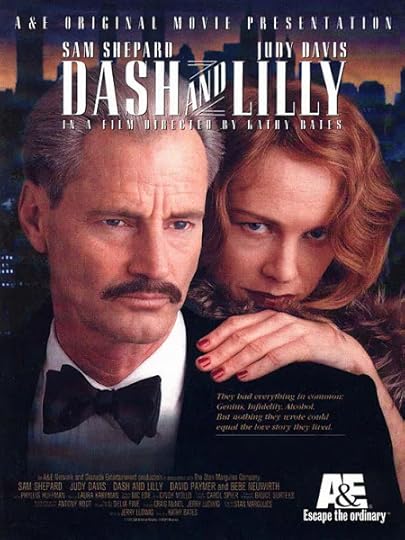 Kathy Bates, dir.: Dash and Lilly (2000)
Kathy Bates, dir.: Dash and Lilly (2000)The reality may not have been quite so glamorous as the picture above, but it's fair to say that they were, in their way, a handsome pair:
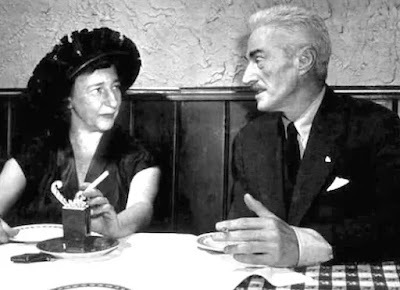 Lillian Hellman & Dashiell Hammett
Lillian Hellman & Dashiell HammettHere are the two of them again, from Fred Zinneman's 1977 movie Julia , based on a chapter from Lillian Hellman's memoir Pentimento: A Book of Portraits (1973):
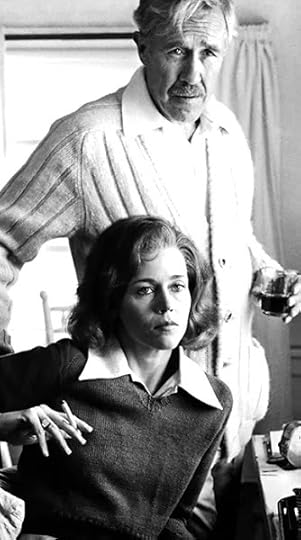 Julia: Jane Fonda as Hellman & Jason Robards as Hammett (1977)
Julia: Jane Fonda as Hellman & Jason Robards as Hammett (1977)They've become one of those legendary couples, like Humphrey Bogart and Lauren Bacall, Clark Gable and Carole Lombard - or Laurence Olivier and Vivien Leigh. Lillian Hellman and Dashiell Hammett, too, were in show business, but on the typewriter side of the ledger rather than in front of the camera.
Except once.
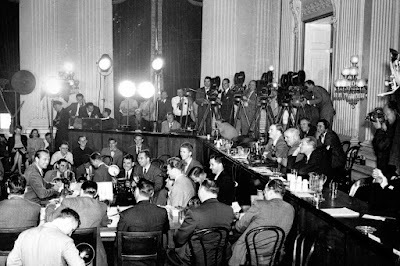
They were also pretty dedicated Communists. Hammett was sent to prison in 1951 when the Civil Rights Congress, of which he was president, was designated a Communist front group by the US Attorney General. He spent over a year in jail for refusing to name any of the people who had contributed to the CRC bail fund, and who might therefore have been liable to being accused of being Reds or Fellow Travellers:
Instead, on every question regarding the CRC or the bail fund, Hammett declined to answer, citing the Fifth Amendment, refusing to even identify his signature or initials on CRC documents the government had subpoenaed.On his release, he was definitively blacklisted, after refusing to cooperate or name names during a further appearance before HUAC, Senator Joseph McCarthy's House Un-American Activities Committee. This had the effect of depriving him of any income from his books or films for virtually the rest of his life.
Perhaps it's sentimental of me, but I find it difficult to argue with Hellman's verdict that he submitted to prison rather than reveal the names of the contributors to the fund because "he had come to the conclusion that a man should keep his word."
The fact that he subsequently revealed that he didn't actually know any of their names - he'd had nothing to do with that particular piece of fund-raising - adds the essential touch of deadpan Hammettian irony to the whole sorry affair.
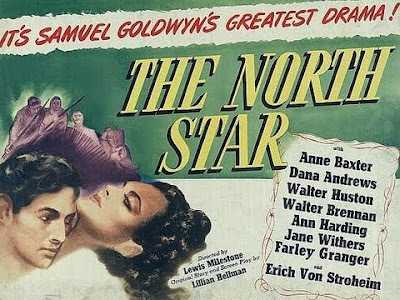 Lewis Milestone, dir.: The North Star (1943)
Lewis Milestone, dir.: The North Star (1943)Hellman herself is a more complex case. She was definitely sympathetic to the Communist line, and her wartime propaganda film North Star shows the most naive attitudes towards Stalinist Russia. However, one should add in her defence that every attempt she made to introduce a tincture of realism into the script was immediately vetoed by the studio.
Despite its absurdities, the film was unexpectedly popular in Russia, as she found when she was despatched on a semi-official visit to America's wartime ally a few months later.
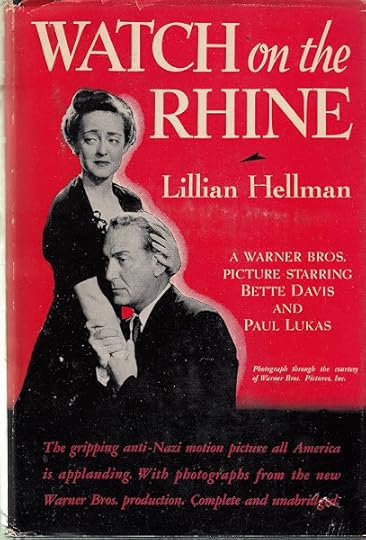 Lillian Hellman: Watch on the Rhine (1941)
Lillian Hellman: Watch on the Rhine (1941)More significantly, at the height of the Nazi-Soviet pact, when anyone toeing the the Communist party line was strictly forbidden from criticising Hitler, her popular stage play "The Watch on the Rhine" argued a fiercely anti-Nazi position. She can hardly therefore be accused of being a simple tool of the party, given the amount of criticism she received from her more radical colleagues for this act of deviationism at the time.
A few months later, after Hitler's invasion of Russia, the same people were queueing up to praise Hellman's "prescient" play to the skies.
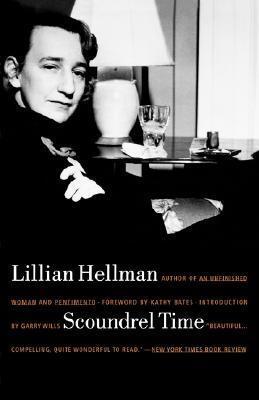 Lillian Hellman: Scoundrel Time (1941)
Lillian Hellman: Scoundrel Time (1941)Hellman's own testimony before HUAC remains a controversial matter to this day. Like Hammett, she refused to name names. However, having seen the effect it had on him, she was also anxious to avoid going to prison, which would have been the inevitable result of her willingness to testify on some matters - such as her own activities in the 1930s and 1940s - but not others, i.e. the names of the people who had participated in the committees and congresses she attended at the time.
Her lawyer, Joseph Rauh, experienced in these matters, advised her to record her views in a letter to the Chairman of the Committee, and then ask to be allowed to read it out at the hearing. While the Committee rejected her request to be permitted to testify only about herself but not others, they did agree to enter her letter into the record.
The moment that decision was handed down, Rauh's assistant promptly started to distribute printed copies of the letter to as many as possible of the journalists present, despite strenuous attempts to stop him by the Committee's security guards. Hellman's (and Rauh's) letter was a rhetorical masterpiece, with one phrase in particular which has gone down in history:
I do not like subversion or disloyalty in any form and if I had ever seen any I would have considered it my duty to have reported it to the proper authorities. But to hurt innocent people whom I knew many years ago in order to save myself is, to me, inhuman and indecent and dishonorable. I cannot and will not cut my conscience to fit this year's fashions [my emphasis], even though I long ago came to the conclusion that I was not a political person and could have no comfortable place in any political group. I was raised in an old-fashioned American tradition and there were certain homely things that were taught to me: to try to tell the truth, not to bear false witness, not to harm my neighbour, to be loyal to my country, and so on. In general, I respected these ideals of Christian honor and did as well as I knew how. It is my belief that you will agree with these simple rules of human decency and will not expect me to violate the good American tradition from which they spring. I would therefore like to come before you and speak of myself.You can't send the grand old lady of American Theatre to jail after she's trumpeted "I cannot and will not cut my conscience to fit this year's fashions" right in your face. The committee saw that they'd been out-grandstanded, and were forced to content themselves with the inevitable blacklisting and loss of all income which followed her appearance before them.
Somewhat of a Pyrrhic victory, one might say, but a victory nevertheless.
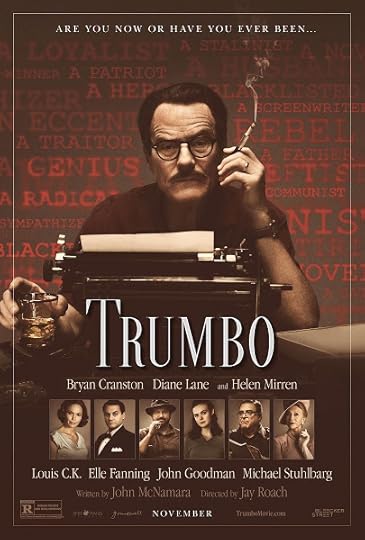 Jay Roach, dir.: Trumbo (2015)
Jay Roach, dir.: Trumbo (2015)So were Hammett and Hellman heroes or villains? Neither, really. They were certainly criminally naive in their judgement of Stalin and Stalinism, but it's hard to see laissez-faire Capitalism as all that much better in the various ways it's raped and pillaged the world we've inherited from these warring ideologies.
Certainly portraying McCarthyism as an evil commensurate with the Soviet gulag, as politically simplistic films such as Trumbo implicitly do, is not really a viable position - but I suppose it's the ease with which all democratic safeguards were set aside in the late 1940s and 1950s which explains why we keep on returning to this period again and again: whether the stricken hero in question be Oppenheimer, Trumbo, or Dashiell Hammett.
 Richard Davenport-Hines: Enemies Within (2019)
Richard Davenport-Hines: Enemies Within (2019)The situation in Britain at this time was complicated by the undeniable presence of actual Communist agents at the highest levels of the government and, in particular, the secret services. Richard Davenport-Hines' recent, rather hysterical, book on the subject attempts to argue that the real damage done by Burgess, Philby, Maclean and co. was to the public's faith in Establishment values.
He attributes BREXIT and various other contemporary follies to the fact that people no longer trust any information that reaches them from "official" channels. Oddly, he fails to see any problem with the actual falsehoods peddled by successive British governments beyond the fact that no-one seems inclined to believe them on their mere say-so anymore.
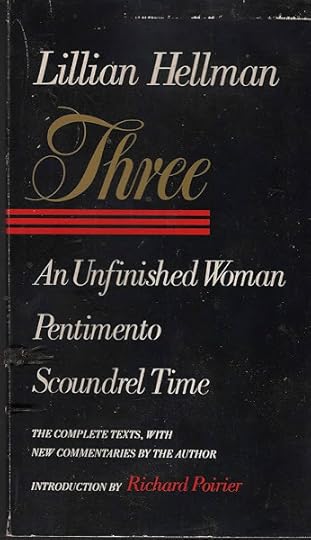 Lillian Hellman: Three: An Unfinished Woman, Pentimento & Scoundrel Time (1979)
Lillian Hellman: Three: An Unfinished Woman, Pentimento & Scoundrel Time (1979)After Hammett's death - and without his restraining critical influence - Hellman decided to set the record straight in a set of very selective and, it would now appear, heavily fictionalised memoirs.
In Pentimento, in particular, she wrote a long section about an old friend of hers, disguised under the pseudonym "Julia", who'd been a political activist in Spain, then Austria, in the late 1930s, and who once asked Hellmann to smuggle some funds to her through Nazi Germany to support the anti-Fascist cause.
The actual existence of this Julia - played by Vanessa Redgrave alongside Jane Fonda's Lillian Hellman in the 1977 film of the same name - has been called into question. It's also been suggested that Julia may have been based on the Freudian psychiatrist Muriel Gardiner, who was indeed active in anti-Fascist politics in Austria at the time.
Hellman, however, denied it, and continued to claim that her story was true, despite the fact that she'd had to change her friend's name. Nor had she ever met Muriel Gardiner. As she wrote to the film's producer at the time:
I do not deny the danger I was in when I took the money into Germany ... And nobody and nothing can change that unless you write a fictional and different story ... Isn't it necessary to know that I am a Jew? That, of course, is what mainly made the danger.Entertaining though they are, and successful though they were at the time, these books gave her enemies all the ammunition they needed to cut her down to size once and for all. Mary McCarthy, in particular, an ex-Trotskyite who'd maintained her hatred of Stalinists since the late 1930s, took the opportunity to denounce Hellman in no uncertain terms on an episode of the Dick Cavett Show:
 Mary McCarthy (1912-1989)
Mary McCarthy (1912-1989)McCarthy ... called Hellman “a bad writer, overrated, a dishonest writer” during an interview with TV host Dick Cavett on his national talk show in late January of 1980. When Cavett asked what exactly was dishonest about Hellmann, McCarthy replied, "Everything. I once said in an interview that everything she writes is a lie, including 'and' and 'the.'"Hellman promptly sued McCarthy for libel, and the case limped along without coming to trial - despite McCarthy's unavailing attempts to have it dismissed on the grounds that "her comments were simply her opinions about a public figure" - until it was abandoned by Hellman's executors after her death in mid-1984.
Admirers of McCarthy's waspish wit continue to quote that "everything she writes is a lie, including 'and' and 'the'" bon mot with glee. Long ago bitchiness from famous figures - even that of long-faded littérateurs such as Mary McCarthy - tends to have that effect.
For myself, despite all the personal and political stumbles she undoubtedly made in her long life, despite all her grande dame affectations and her admitted elisions of history, I find that Hellman appeals to me in a way her two principal detractors - both of them surnamed McCarthy, oddly enough - do not.
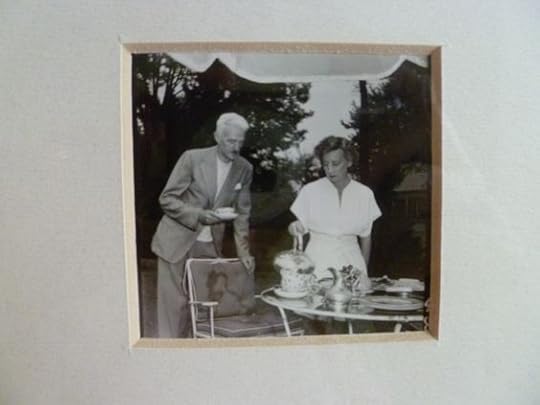 Beth Lipson: Lillian Hellman and Dashiell Hammett
Beth Lipson: Lillian Hellman and Dashiell HammettFor all its ups-and-downs and complexities, the Hellman-Hammett alliance still has a certain lustre to it. They may have been complex, flawed people, but they were willing to put everything on the line when it counted. Hellman's famous letter to the committee was certainly a very calculated act of defiance, but defiant it undoubtedly was:
... to hurt innocent people whom I knew many years ago in order to save myself is, to me, inhuman and indecent and dishonorable. I cannot and will not cut my conscience to fit this year's fashions ... I was raised in an old-fashioned American tradition and there were certain homely things that were taught to me: to try to tell the truth, not to bear false witness, not to harm my neighbour, to be loyal to my country, and so on. In general, I respected these ideals of Christian honor and did as well as I knew how.That phrase about "Christian honor" may sound a little discordant to us now, but when you consider it comes from a Jewish woman writer, one who fought Hitler and Fascism long before it became fashionable, it takes on a more complex meaning.
This was a woman who dispassionately analysed the wrongs of her own family and caste in such plays as The Little Foxes (1939), wrote presciently about witch-hunts in her first play The Children's Hour (1934), and who thought nothing of defying every convention of "womanly" behaviour in her own private life.
She was, in short, every male chauvinist's worst nightmare. The laconic Dashiell Hammett needs no defence from me or anyone else, given his almost mythic status in American letters. I do, however, think it's high time for a bit more celebration of his partner in life and literature, Lillian Hellman.
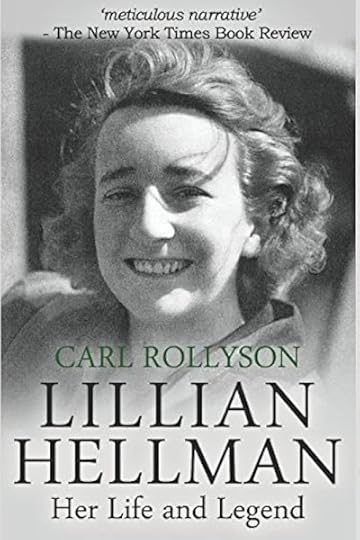 Carl Rollyson: Lillian Hellman: Her Life and Legend (1912-1989)
Carl Rollyson: Lillian Hellman: Her Life and Legend (1912-1989)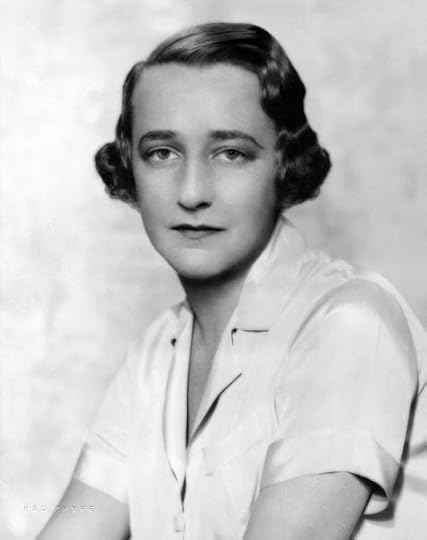 Lillian Hellman (1935)
Lillian Hellman (1935)Lillian Florence Hellman
(1905–1984)
Books I own are marked in bold:Plays:
The Children's Hour (1934)Days to Come (1936)The Little Foxes (1939)The Little Foxes: A Play in Three Acts. New York: Random House, 1939. Watch on the Rhine (1941)Four Plays: The Children's Hour / Days to Come / The Little Foxes / Watch on the Rhine (1942)The Searching Wind (1944)Another Part of the Forest (1946)Montserrat [Adapted from Emmanuel Robles' play] (1949)The Autumn Garden (1951)The Lark [Adapted from Jean Anouilh's play L'Alouette] (1955)Toys in the Attic (1960)Six Plays: The Children's Hour / Days to Come / The Little Foxes / Watch on the Rhine / Another Part of the Forest / The Autumn Garden (1960)My Mother, My Father and Me [Adapted from Burt Blechman's novel How Much?] (1963)The Collected Plays: The Children's Hour / Days to Come / The Little Foxes / Watch on the Rhine / The Searching Wind / Another Part of the Forest / Montserrat / The Autumn Garden / The Lark / Candide / Toys in the Attic / My Mother, My Father and Me (1972)
Novel:
Maybe: A Story (1980)
Operetta:
Candide (1956)
Screenplays:
[with Mordaunt Shairp] The Dark Angel [based on the play by Guy Bolton] (1935)These Three [based on her play The Children's Hour] (1936)Dead End [based on the play by Sidney Kingsley] (1937)The Little Foxes [based on her play] (1941)The North Star (1943)The Searching Wind [based on her play] (1946)The Chase [based on the play by Horton Foote] (1966)
Memoirs:
An Unfinished Woman: A Memoir (1969)Pentimento: A Book of Portraits (1973)Scoundrel Time (1976)Three (1979)Three: An Unfinished Woman: A Memoir / Pentimento / Scoundrel Time: With New Commentaries by the Author. 1969, 1973 & 1976. Introduction by Richard Poirier. London: Macmillan London Limited, 1979. [with Peter Feibleman] Eating Together: Recipes and Recollections, with Peter Feibleman (1984)
Edited:
The Selected Letters Of Anton Chekhov (1955)Dashiell Hammett: The Big Knockover (1966)The Dashiell Hammett Story Omnibus. Ed. Lillian Hellman. London: Cassell & Co. Ltd., 1966.
Secondary:
Rollyson, Carl. Lillian Hellman: Her Legend and Her Legacy. New York: St. Martin's Press, 1988.
•
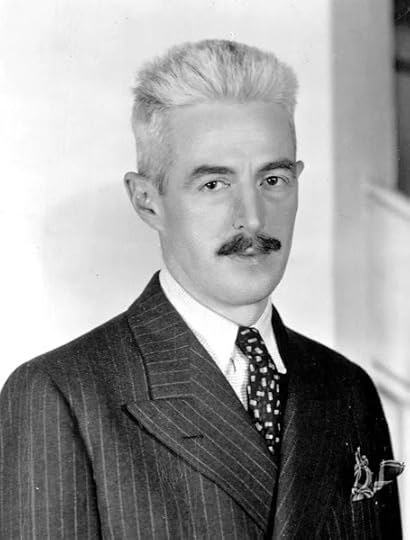 Dashiell Hammett (1935)
Dashiell Hammett (1935)Samuel Dashiell Hammett
(1894–1961)
Novels:
Red Harvest (1929)The Dain Curse (1929)The Maltese Falcon (1930)The Glass Key (1931)The Thin Man (1934)The Dashiell Hammett Omnibus (1950) [DHO]Red HarvestDead Yellow WomenThe Dain CurseThe Golden HorseshoeThe Maltese FalconHouse DickThe Glass KeyWho Killed Bob Teal?The Thin Man The Dashiell Hammett Omnibus: Red Harvest / The Dain Curse / The Maltese Falcon / TheGlass Key / The Thin Man & Four Short Stories. A Crime Connnoisseur Book. London: Cassell & Co. Ltd., 1950. Complete Novels. Ed. Steven Marcus (Library of America, 1999)Complete Novels: Red Harvest; The Dain Curse; The Maltese Falcon; The Glass Key; The Thin Man. Ed. Steven Marcus. The Library of America, 110. New York: Literary Classics of the United States, Inc., 1999.
Short Stories:
The Big Knockover. Ed. Lillian Hellman (1966) [BK]The Gutting of CouffignalFly PaperThe Scorched FaceThis King BusinessThe Gatewood CaperDead Yellow WomenCorkscrewTulipThe Big Knock-Over$106,000 Blood Money The Dashiell Hammett Story Omnibus [aka "The Big Knockover"]. Ed. Lillian Hellman. London: Cassell & Co. Ltd., 1966. The Continental Op. Ed. Steven Marcus (1974) [CO]The Tenth ClewThe Golden HorseshoeThe House in Turk StreetThe Girl with the Silver EyesThe Whosis KidThe Main DeathThe Farewell Murder The Continental Op. Ed. Steven Marcus. 1974. Picador. London: Pan Books Ltd., 1977. Nightmare Town (1999) [NT]Crime Stories and Other Writings. Ed. Steven Marcus. (Library of America, 2001) [CS]Crime Stories:Arson PlusSlippery FingersCrooked SoulsThe Tenth ClewZigzags of TreacheryThe House in Turk StreetThe Girl with the Silver EyesWomen, Politics and MurderThe Golden HorseshoeNightmare TownThe Whosis KidThe Scorched FaceDead Yellow WomenThe Gutting of CouffignalThe Assistant MurdererCreeping SiameseThe Big Knock-Over$106,000 Blood MoneyThe Main DeathThis King BusinessFly PaperThe Farewell MurderWoman in the DarkTwo Sharp KnivesOther Writings:The Thin Man: An Early TypescriptFrom the Memoirs of a Private DetectiveSuggestions to Detective Story WritersCrime Stories and Other Writings. Ed. Steven Marcus. The Library of America, 125. New York: Literary Classics of the United States, Inc., 2001. Lost Stories. Introduction by Joe Gores (2005) [LS]The Hunter and Other Stories. Ed. Richard Layman & Julie M. Rivett (2013) [Hunter]The Big Book of the Continental Op (2017) [BCO]
Stories:
The Parthian Shot (1922) [LS][as Daghull Hammett] Immortality (1922) [LS][as Peter Collinson] The Barber and His Wife (1922) [LS][as Peter Collinson] The Road Home (1922) [LS]The Master Mind (1923) [LS][as Peter Collinson] The Sardonic Star of Tom Doody [aka "Wages of Crime"] (1923) [LS][as Peter Collinson] The Vicious Circle [aka “The Man Who Stood in the Way”] (1923) [Woman in the Dark (1951)]The Joke on Eloise Morey (1923) [LS]Holiday (1923) [LS][as Mary Jane Hammett] The Crusader (1923) [LS][as Peter Collinson] Arson Plus (1923) [CS] [BCO]The Dimple [aka "In the Morgue"] (1923) [LS]Crooked Souls [aka "The Gatewood Caper"] (1923) [BK] [CS] [BCO][as Peter Collinson] Slippery Fingers (1923) [CS] [BCO]The Green Elephant (1923) [LS]It [aka "The Black Hat That Wasn't There"] (1923) [BCO]The Second-Story Angel (1923) [NT][as Peter Collinson] Laughing Masks [aka "When Luck's Running Good"] (1923) [LS]Bodies Piled Up [aka "House Dick"] (1923) [DHO] [BCO][as Peter Collinson] Itchy [aka "Itchy the Debonair"] (1924) [LS]The Tenth Clew [aka "The Tenth Clue"] (1924) [CO] [CS] [BCO]The Man Who Killed Dan Odams (1924) [NT]Night Shots (1924) [BCO]The New Racket [aka "The Judge Laughed Last"] (1924) [The Adventures of Sam Spade (1944)]Esther Entertains (1924) [LS]Afraid of a Gun (1924) [NT]Zigzags of Treachery (1924) [CS] [BCO]One Hour (1924) [BCO]The House in Turk Street (1924) [CO] [CS] [BCO]The Girl with the Silver Eyes (1924) [CO] [CS] [BCO]Women, Politics and Murder [aka "Death on Pine Street" / "A Tale of Two Women"] (1924) [CS] [BCO]The Golden Horseshoe (1924) [CO] [CS] [DHO] [BCO]Who Killed Bob Teal? (1924) [DHO] [BCO]Nightmare Town (1924) [CS]Mike, Alec or Rufus? [aka "Tom, Dick or Harry?"] (1925) [BCO]Another Perfect Crime (1925) [LS]The Whosis Kid (1925) [CO] [CS] [BCO] Ber-Bulu [aka "The Hairy One"] (1925) [LS]The Scorched Face (1925) [BK] [CS] [BCO]Corkscrew (1925) [BK] [BCO]Ruffian's Wife (1925) [NT]Dead Yellow Women (1925) [DHO] [BK] [CS] [BCO]The Glass That Laughed (1925) [Electric Literature (2017)]The Gutting of Couffignal (1925) [BK] [CS] [BCO]The Nails in Mr. Cayterer (1926) [The Creeping Siamese (1950)]The Assistant Murderer [aka "First Aide to Murder"] (1926) [CS]Creeping Siamese (1926) [CS] [BCO]The Advertising Man Writes a Love Letter (1927) [LS]The Big Knock-Over (1927) [BK] [CS] [BCO]$106,000 Blood Money (1927) [BK] [CS] [BCO]The Main Death (1927) [CO] [CS] [BCO]The Cleansing of Poisonville [reworked into Red Harvest] (1927) [BCO]Crime Wanted—Male or Female [reworked into Red Harvest] (1927) [BCO]This King Business (1928) [BK] [CS] [BCO]Dynamite [reworked into Red Harvest] (1928) [BCO]The 19th Murder [reworked into Red Harvest] (1928) [BCO]Black Lives [reworked into The Dain Curse] (1928) [BCO]The Hollow Temple [reworked into The Dain Curse] (1928) [BCO]Black Honeymoon [reworked into The Dain Curse] (1929) [BCO]Black Riddle [reworked into The Dain Curse] (1929) [BCO]Fly Paper (1929) [BK] [CS] [BCO][as Samuel Dashiell] The Diamond Wager (1929) [Hunter]The Farewell Murder (1930) [CO] [CS] [BCO]The Glass Key [reworked into The Glass Key] (1930)The Cyclone Shot [reworked into The Glass Key] (1930)Dagger Point [reworked into The Glass Key] (1930)The Shattered Key [reworked into The Glass Key] (1930)Death and Company (1930) [BCO]On the Way (1932) [Hunter]A Man Called Spade (1932) [NT]Too Many Have Lived (1932) [NT]They Can Only Hang You Once [aka ] (1932) [NT]Woman in the Dark [3 parts] (1933) [CS]Night Shade (1933) [LS]Albert Pastor at Home (1933) [Nightmare Town (1948)]Two Sharp Knives [aka "To a Sharp Knife"] (1934) [CS]His Brother's Keeper (1934) [NT]This Little Pig (1934) [LS]The Thin Man and the Flack (1941) [LS] Tulip [unfinished novel] [BK]A Man Named Thin [aka "The Figure of Incongruity"] (1961) [NT]Seven Pages (2005) [Hunter]Faith (2007) [Hunter]So I Shot Him [aka "The Cure"] (2011 [Hunter]The Hunter (2013) [Hunter]The Sign of the Potent Pills (2013) [Hunter]Action and the Quiz Kid (2013) [Hunter]Fragments of Justice (2013) [Hunter]A Throne for the Worm (2013) [Hunter]Magic (2013) [Hunter]An Inch and a Half of Glory (2013) [Hunter]Nelson Redline (2013) [Hunter]Monk and Johnny Fox (2013) [Hunter]The Breech-Born (2013) [Hunter]The Lovely Strangers (2013) [Hunter]Week-End (2013) [Hunter]A Knife Will Cut for Anybody [Unfinished] (2013)[Hunter]The Secret Emperor [Unfinished] (2013)[Hunter]Time to Die [Unfinished] (2013) [Hunter]September 20, 1938 [Unfinished] (2013)[Hunter]Three Dimes [Unfinished] (2017) [BCO]The Man Who Loved Ugly Women (n.d.) [LS]
Screenplays:
Watch on the Rhine [based on Lillian Hellman's play] (1943)
Screen Stories:
The Kiss-Off [City Streets] (1931) [Hunter]Devil's Playground [unproduced] [Hunter]On the Make [Mister Dynamite] (1935) [Hunter]After the Thin Man (1936) [Hunter]Another Thin Man (1939) [Hunter]Sequel to the Thin Man [unproduced] [Hunter]
Non-fiction:
The Great Lovers (The Smart Set, 1922)From the Memoirs of a Private Detective (The Smart Set, 1923)In Defence of the Sex Story (The Writer's Digest, 1924)Three Favorites (Black Mask, 1924, Short autobiographies of Francis James, Dashiell Hammett and C. J. Daly.)Vamping Sampson (The Editor, 1925)The Advertisement IS Literature (Western Advertising, 1926)Advertising Art Isn't Art —- It's Advertising (Western Advertising, 1927)Have You Tried Meiosis? (Western Advertising, 1928)The Literature of Advertising in 1927 (Western Advertising, 1928)The Editor Knows His Audience (Western Advertising, 1928)[with Robert Colodny] The Battle of the Aleutians. [pamphlet]. Illustrated by Harry Fletcher. Adak, Alaska: Field Force Headquarters, 1944.
Edited:
Creeps by Night: Chills and Thrills (1931)
Comics:
Secret Agent X-9, Book 1. [Daily comic strip]. Illustrated by Alex Raymond (David McKay Publications, 1934)Secret Agent X-9, Book 2. Illustrated by Alex Raymond (David McKay Publications, 1934)Secret Agent X-9. Illustrated by Alex Raymond (Nostalgia Press, NY, 1976)Dashiell Hammett's Secret Agent X-9. Illustrated by Alex Raymond (International Polygonics Ltd, 1983)Secret Agent X-9. Illustrated by Alex Raymond (Kitchen Sink Press, 1990)[with Leslie Charteris] Secret Agent X-9. Illustrated by Alex Raymond (IDW Publishing, 2015)
Film Adaptations:
Roadhouse Nights [adaptation of Red Harvest] (1930)The Maltese Falcon (1931)Woman in the Dark (1934)The Thin Man (1934)The Glass Key (1935)Satan Met a Lady [adaptation of The Maltese Falcon] (1936)After the Thin Man (1936)Another Thin Man (1939)The Maltese Falcon (1941)The Glass Key (1942)No Good Deed [adaptation of "The House in Turk Street"] (2002)
Letters:
The Selected Letters of Dashiell Hammett, 1921-1960. Ed. Richard Layman & Julie M. Rivett. Introduction by Josephine Hammett Marshall. Washington, DC: Counterpoint, 2001.
Secondary:
Johnson, Diane. Dashiell Hammett: A Life. New York: Random House, 1983.
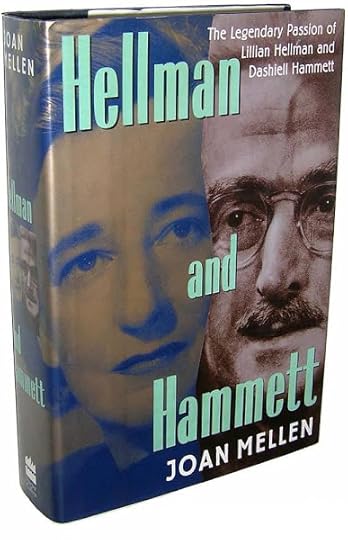 Joan Mellen: Hellman and Hammett (1996)
Joan Mellen: Hellman and Hammett (1996)•
Published on October 17, 2024 13:11
October 12, 2024
The Bounty Mythos
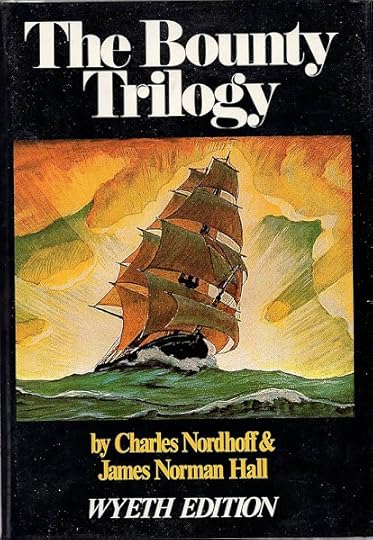 Nordhoff & Hall: The Bounty Trilogy (1982)
Nordhoff & Hall: The Bounty Trilogy (1982)Charles Nordhoff & James Norman Hall: The Bounty Trilogy: Comprising the Three Volumes Mutiny on the Bounty; Men Against the Sea; Pitcairn’s Island. 1932, 1933, 1934, 1936. Illustrated by N. C. Wyeth. 1940. An Atlantic Monthly Press Book. Boston & Toronto: Little, Brown & Company, 1982.
Date: 28th April, 1789. Place: the middle of the Pacific Ocean. The most famous mutiny in history is about to break out.
The storming of the Bastille in Paris would not take place until July 14th of that year, but stormclouds were already looming over the Bourbon monarchy. Or, as William Blake put it in his projected seven-part epic The French Revolution (1791):
The dead brood over Europe, the cloud and vision descends overNor would the rest of the British navy be exempt from the shockwaves of these great events. Less than a decade after the Bounty mutiny, the fleet would endure two of the worst uprisings in their history: at Spithead (April to May 1797) and the Nore (May to June 1797).
chearful France ...
Both of these mutinies involved multiple ships and men. At the Nore, Richard Parker, the self-styled President of the "Floating Republic", made no secret of his admiration for the French Revolution and for its declared principles of liberty, equality, and fraternity - ideas taken straight from Tom Paine's The Rights of Man (1791).
The crew of Bligh's ship, HMS Director, put him ashore - like most of their other commanding officers - during the Nore rebellion. There's no evidence that he was treated more harshly than anyone else on that occasion. It was, nevertheless, the second of three mutinies against his leadership during his long career.
So it's probably fair to say that a spirit of radicalism was beginning to pervade the British navy even before the crew of the Bounty, and their ringleader, Fletcher Christian, were (or so the story goes) seduced by the comforts of "Aphrodite's Island", Tahiti.
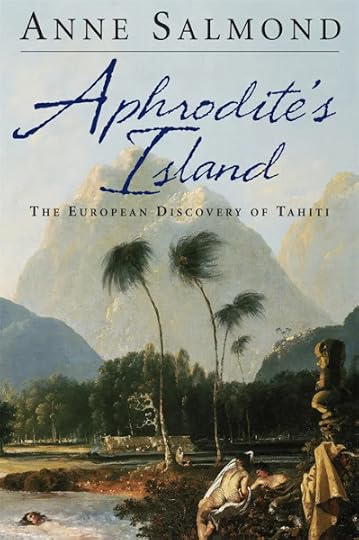 Anne Salmond: Aphrodite's Island (2009)
Anne Salmond: Aphrodite's Island (2009)Anne Salmond. Aphrodite's Island: The European Discovery of Tahiti. Viking. Auckland: Penguin Group (NZ), 2009.
Whatever the causes of the Bounty mutiny - whether or not Captain Bligh actually was the foaming, flogging monster of legend, or just a firm-but-fair, by-the-book commander, as various revisionist historians have claimed - it's been written about and dramatised almost continuously since.
The fact that Bligh was yet again deposed as Governor of New South Wales by rebellious officers in 1808 makes him seem, at the very least, somewhat misguided in his methods of governance. Or, to paraphrase Lady Bracknell in The Importance of Being Earnest:
To lose one command, Captain Bligh, may be regarded as a misfortune; to lose three looks like carelessness.In any case, I was happy to find a copy of Charles Nordhoff & James Norman Hall's classic Bounty trilogy in Devonport the other day. I read my father's scruffy paperback copies of the three books many years ago, as a teenager, and they made a deep impression on me.
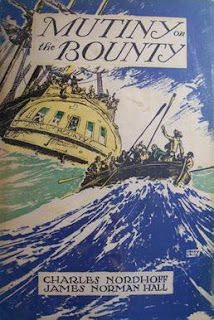 Nordhoff & Hall: Mutiny on the Bounty (1932)
Nordhoff & Hall: Mutiny on the Bounty (1932)Nordhoff, Charles, & James Norman Hall. Mutiny on the Bounty. 1932. Four Square Books. London: New English Library / Sydney: Horwitz Publications, 1961.
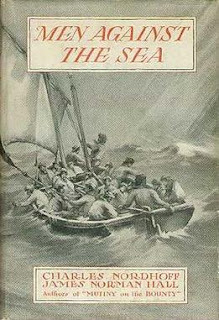 Nordhoff & Hall: Men Against the Sea (1933)
Nordhoff & Hall: Men Against the Sea (1933)Nordhoff, Charles, & James Norman Hall. Men Against the Sea. 1933. Fontana Books. London: Collins, 1956.
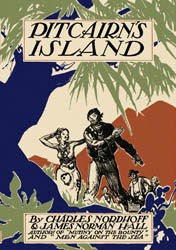 Nordhoff & Hall: Pitcairn’s Island (1934)
Nordhoff & Hall: Pitcairn’s Island (1934)Nordhoff, Charles, & James Norman Hall. Pitcairn’s Island. 1934. New York: Pocket Books, 1976. I think it was the last, the one about all the things that went down on Pitcairn after the mutiny, which impressed me most. There was a relentless horror about it which reminds me more than a little of the wreck of the Batavia, 150 years before.
In any case, I thought it might be interesting to list here the main accounts - and dramatisations - of the Bounty mutiny which I've collected over the years. There are quite a few of them, though I'd have to stress that this collection is in no way exhaustive: a complete Bounty bibliography would no doubt stretch to many pages.
•
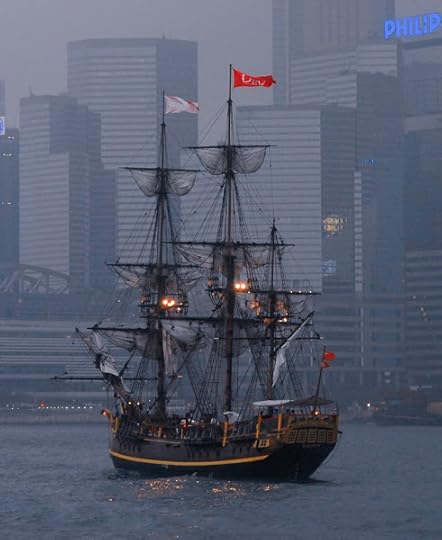 The Bounty Replica in Hong Kong (1978)
The Bounty Replica in Hong Kong (1978)Books I own are marked in bold:
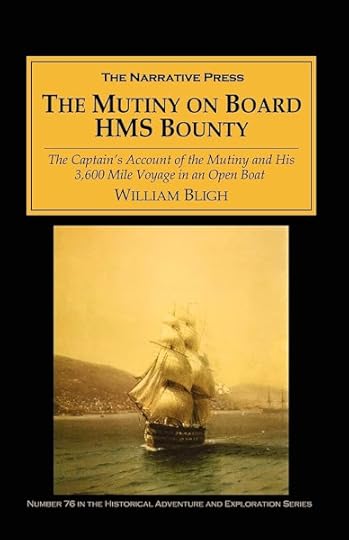 William Bligh (1754-1817): The Mutiny on Board H.M.S. Bounty (1790)
William Bligh (1754-1817): The Mutiny on Board H.M.S. Bounty (1790)William Bligh. The Mutiny on Board H.M.S. Bounty. 1790. Afterword by Milton Rugoff. A Signet Classic. New York: New American Library, 1961.
It's generally best to get your own version of events out there first. Bligh's account is perhaps more notable for what it doesn't say than what it does. Despite the huge gaps in his story, though, what he chooses to tell us seems to be reasonably accurate.
There the whole matter might have rested if it hadn't been for the rediscovery of Pitcairn island - colonised in 1790 by nine Bounty mutineers, together with eighteen Tahitian men and women - by the American sealing ship Topaz, under Mayhew Folger, in February 1808.
Folger's report, which mentioned the presence there of the last surviving mutineer, John Adams, was forwarded to the Admiralty, together with a more accurate location for the island.
None of this was, however, known to Sir Thomas Staines of the Royal Navy, whose two ships visited Pitcairn on 17 September 1814. As a result, John Adams, now the patriarch of the small community, was pardoned for his part in the mutiny, and the rest of the islanders were left in peace.
•
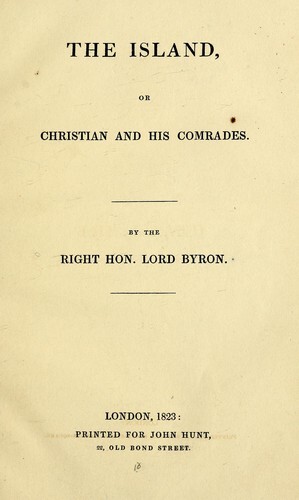 George Gordon, Lord Byron (1788-1824): The Island (1823)
George Gordon, Lord Byron (1788-1824): The Island (1823)Lord Byron. "The Island". The Poetical Works. Ed. Frederick Page. 1904. Rev. ed. 1945. Oxford Standard Authors. London: Oxford University Press, 1959. 349-66.
Lord Byron's long narrative poem "The Island; or, Christian and His Comrades" is one of the last pieces he wrote before leaving for Greece in July 1823. He died there of fever less than a year later.
His poem has received rather mixed reviews. It lacks the humour and zest of his late masterpiece Don Juan (1819-24), but also fails to rekindle the revolutionary passion of early works such as Childe Harold's Pilgrimage (1812-18).
On the one hand, his completely fictionalised picture of life on the island is clearly inspired by Rousseau's idea of the Noble Savage; on the other hand, his revulsion from politics makes it impossible for him to endorse the radical, levelling ideas of the original mutineers.
His poem seems, in many ways, more inspired by a desire to assert kinship with his seagoing grandfather "Foul-Weather Jack" Byron, who survived a terrifying shipwreck as a young midshipman in the 1740s, and subsequently circumnavigated the globe in the 1760s (a few years before Captain Cook), than by any real sympathy for Christian and his comrades.
•
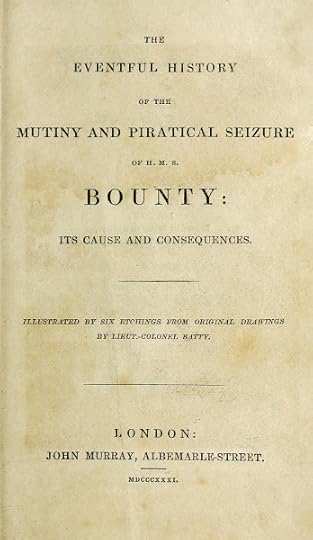 John Barrow (1764-1848): The Eventful History of H.M.S. Bounty (1831)
John Barrow (1764-1848): The Eventful History of H.M.S. Bounty (1831)Sir John Barrow. The Eventful History of the Mutiny and Piratical Seizure of HMS BOUNTY its Causes and Consequences. 1831. Ed. Captain Stephen W. Roskill. London: The Folio Society, 1976.
This is widely considered to be the classic account of the mutiny and its aftermath. It begins with an account of the island of Tahiti, and concludes with a full discussion of events on Pitcairn. The narrative is based firmly on the surviving documentary record.
Its author, Sir John Barrow, is discussed in detail in the 1998 book Barrow's Boys, by Fergus Fleming. His zeal for exploration in general - particularly Arctic expeditions - was vital in maintaining public interest in the voyages of discovery by such luminaries as Sir John Ross, Sir William Edward Parry, Sir James Clark Ross, and Sir John Franklin. The Barrow Strait in the Canadian Arctic, as well as Point Barrow and the city of Barrow in Alaska are named after him.
Barrow was what would now be called a career civil servant, working for successive administrations as Permanent Secretary to the Admiralty. It was his forty-year incumbency of this post which allowed him to exert such a strong influence on the direction of nineteenth century British exploration. He was not, by most accounts, particularly susceptible to correction: an Establishment man through and through.
•
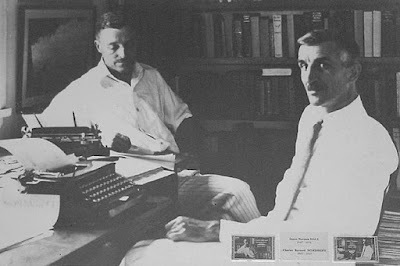 James Norman Hall (1887–1951)
James Norman Hall (1887–1951)& Charles Bernard Nordhoff (1887-1947)
Charles Nordhoff & James Norman Hall: The Bounty Trilogy: Comprising the Three Volumes Mutiny on the Bounty; Men Against the Sea; Pitcairn’s Island. 1932, 1933, 1934, 1936. Illustrated by N. C. Wyeth. 1940. An Atlantic Monthly Press Book. Boston & Toronto: Little, Brown & Company, 1982.
Nordhoff and Hall made friends during the First World War. They were both members of the famous Lafayette Escadrille, and their first collaboration was on a history of the squadron and its wartime exploits.
It was Nordhoff who suggested that the two of them move to Tahiti and work on more books about life in the South Seas. After a few false starts, their first big success came with the novel Mutiny on the Bounty and its two sequels. The Hurricane (1936) is probably the only other one of their novels to strike a nerve with the public.
As with The Hurricane, it was the film adaptation of Mutiny on the Bounty which has kept it in print ever since. Which is a pity, as it's a far better book than one might assume.
The two men's paths diverged in 1936, when Nordhoff left Tahiti. He died, an embittered alcoholic, in California in 1947. James Norman Hall, by contrast, stayed on in Tahiti, with his part-Polynesian wife Sarah (Lala) Winchester. They had two children, Nancy and Conrad, the latter of whom became the Academy-award winning cinematographer of such fims as In Cold Blood (1967), Butch Cassidy and the Sundance Kid (1969), and American Beauty (1999).
•
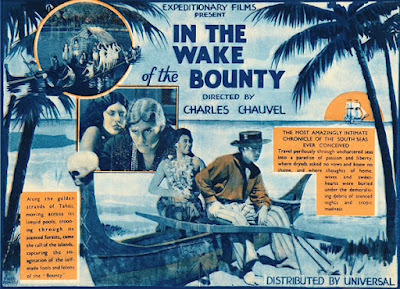 Charles Chauvel (1897-1959): In the Wake of the Bounty (1933)
Charles Chauvel (1897-1959): In the Wake of the Bounty (1933)In the Wake of the Bounty, directed & written by Charles Chauvel; starring Arthur Greenaway, Mayne Lynton, Errol Flynn, Victor Gouriet, & John Warwick (Australia, 1933)
This is the first of four major feature films inspired by the Bounty story. It also marked the screen debut of Tasmanian-born actor Errol Flynn, the first of the bankable Hollywood stars (the others are Clark Gable, Marlon Brando, and Mel Gibson) to have taken on the role of Fletcher Christian. It's important, however, to note - for patriotic reasons if no others - that there was at least one film on the topic before this:I have to confess to not having seen either of these two films. The first remains unavailable, and the second, made in Australia in the early days of sound, is - by all accounts - a fairly stilted affair.
The Mutiny of the Bounty is a 1916 Australian-New Zealand silent film directed by Raymond Longford ... It is the first known cinematic dramatisation of this story and is considered a lost film.
Its one major selling point at the time was the chance to see some documentary-style footage of life on Pitcairn Island, complete with Polynesian dancers and some footage of "an underwater shipwreck, filmed with a glass bottomed boat, which [Chauvel] believed was the Bounty but was probably not."
•
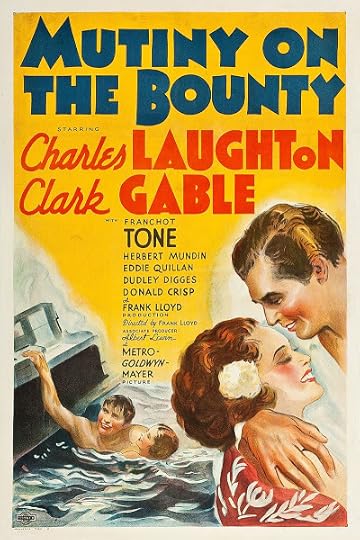 Frank Lloyd (1886-1960): Mutiny on the Bounty (1935)
Frank Lloyd (1886-1960): Mutiny on the Bounty (1935)Mutiny on the Bounty, dir. Frank Lloyd, written by Talbot Jennings, Jules Furthman, Carey Wilson, & John Farrow; based on Mutiny on the Bounty (1932) & Men Against the Sea (1933), by Charles Nordhoff & James Norman Hall; starring Charles Laughton, Clark Gable, Franchot Tone, Movita Castaneda, & Mamo Clark (USA, 1935)
I doubt that it's a picture that anyone can ever erase from their minds: Charles Laughton mopping and mowing and generally biting the scenery as that epitome of all tyrants, Captain Bligh.
How dare this limey mountebank hassle the king of cool, Clark Gable, at the apex of his screen popularity!
If the official line on the mutiny - that it was the work of a few disaffected malcontents, and undertaken against the will of most of the crew - had more or less prevailed up to this point, this film achieved an almost complete paradigm shift.
From now on it was clear that Fletcher Christian was - in spirit if not in fact - an honorary American, whereas Captain Bligh was a true-blue, beef-guzzling Englishman. They might as well have been labelled "Thomas Jefferson" and "King George" in the way they were portrayed.
•
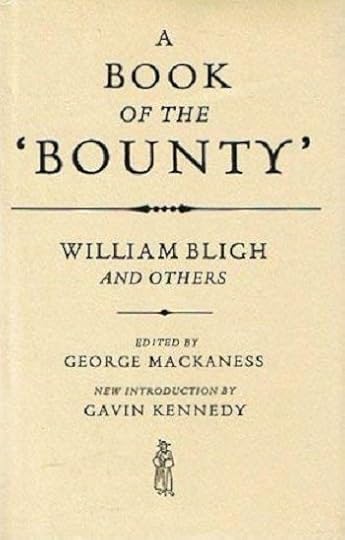 George Mackaness (1882-1968): A Book of the Bounty (1938)
George Mackaness (1882-1968): A Book of the Bounty (1938)George Mackaness, ed. A Book of the 'Bounty' and Selections from Bligh's Writings. 1790, 1792, 1794. Everyman's Library, 1950. London: J. M. Dent & Sons Ltd. / New York: E. P. Dutton & Co. Inc., 1938.
The Empire always does its best to strike back, however. The Book of the Bounty is a balanced and judicious attempt to set the record straight by returning to the remaining documentary evidence.
For the most part it's an edition of all of the writings of Captain Bligh on the subject - not just the book listed at the top of this post.
As well as this, Mackaness, an Australian bibliophile and antiquarian, has included transcripts of the original court martial and other useful witness accounts.
But try setting this rather dry-as-dust approach against the brilliance of the 1935 MGM epic - not to mention the powerful and very readable novels that inspired it - and see how far you get!
•
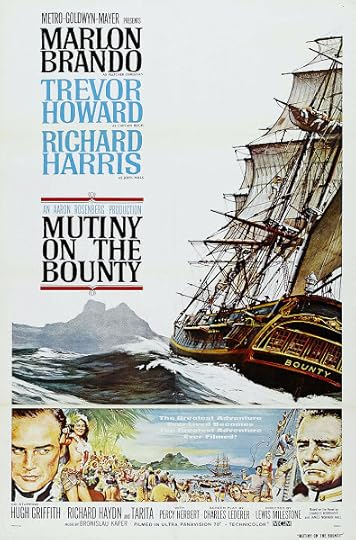 Lewis Milestone (1895-1980): Mutiny on the Bounty (1962)
Lewis Milestone (1895-1980): Mutiny on the Bounty (1962)Mutiny on the Bounty, directed by Lewis Milestone; written by Charles Lederer; based on Mutiny on the Bounty (1932) by Charles Nordhoff & James Norman Hall;starring Marlon Brando; Trevor Howard; Richard Harris; Hugh Griffith; Richard Haydn; Tarita (USA, 1962)
Times change, however, and - probably for as much for copyright reasons as any others - MGM decided that it might be wise to revisit their property 25 years after the first film was released.
In an age of excessively overblown budgets and unprecedented interference by stars, however, Brando's turn to play Christian was an entirely different matter from Errol Flynn's or Clark Gable's.
It was, for a brief time, the most expensive film ever made - until it was supplanted by Liz Taylor's Cleopatra a year or so later. Filming on location is always costly, and the original director, Carol Reed, was forced to leave three months into the shoot. His successor, Lewis Milestone, was unable to communicate with Brando, who was described by a New Yorker critic as playing "Fletcher Christian as a sort of seagoing Hamlet."Indeed, we tend to sympathize with the wicked Captain Bligh, well played by Trevor Howard. No wonder he behaved badly, with that highborn young fop provoking him at every turn!Ouch! The film did do quite well at the box office, and the beauty of the setting was undeniable, but the cost overruns were such that it would have had to do unprecedented business to get out of the red.
•
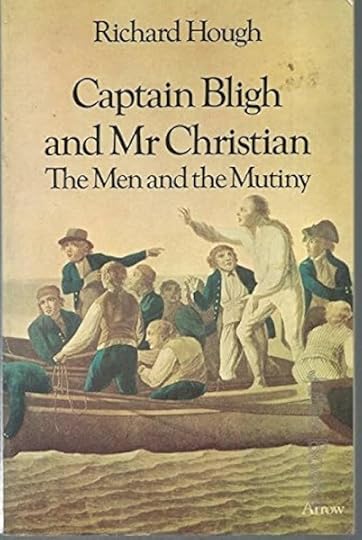 Richard Hough (1922-1999): Captain Bligh and Mr Christian (1972)
Richard Hough (1922-1999): Captain Bligh and Mr Christian (1972)Richard Hough: Captain Bligh and Mr Christian: The Men and the Mutiny. 1972. London: Arrow Books, 1974.
My father swore by this book. In fact, every time the subject came up, he would ask: "Have you read Captain Bligh and Mr Christian?"
It is, indeed, quite a revolutionary restatement of the original context of this much misunderstood event. The fact of Bligh and Christian's previous friendship, and a host of other details ignored by previous writers, put the mutiny in a completely different light.
Many of these revelations have been revised or expanded on since, but it remains an indispensable source of information on the historiography of the Bounty, as well as the actual events associated with the mutiny.
•
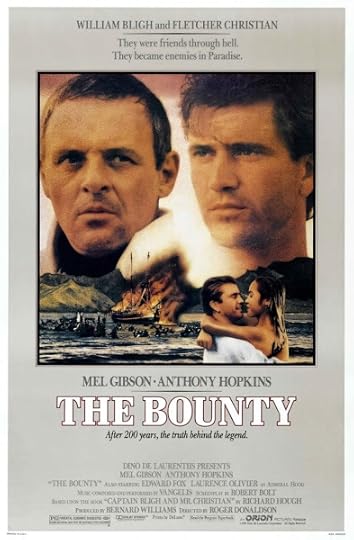 Roger Donaldson (1945- ): The Bounty (1984)
Roger Donaldson (1945- ): The Bounty (1984)The Bounty, directed by Roger Donaldson, written by Robert Bolt; based on Captain Bligh and Mr. Christian (1972), by Richard Hough; starring Mel Gibson, Anthony Hopkins, Edward Fox, Laurence Olivier (UK, 1984)
As an abject fan of David Lean's movies, the news that he was working on a pair of films about the Bounty mutiny during the long hiatus between Ryan's Daughter (1970) and A Passage to India (1984) was pretty thrilling.
A replica Bounty was built, but the mechanics of the project could never be settled, so all that actually resulted from Lean's extensive preparations was the documentary Lost and Found: The Story of Cook's Anchor (NZ, 1979).
Instead, the Bounty film ended up in the blander but probably more business-like hands of Australian / NZ filmmaker Roger Donaldson.
Once again, casting was everything: Mel Gibson had the right New World credentials to play an old-school rebellious Fletcher Christian (a kind of pallid forerunner of his immortal William Wallace). Anthony Hopkins, by contrast, tried to dial back any suggestions of Charles Laughton in favour of a quieter portrayal: a kind of Hannibal-Lecter-in-waiting, one might say.
The script had finally morphed from the Nordhoff-Hall version to Richard Hough's revisionist account, and the results must be said to be richly entertaining - if a little thin in parts. Certainly it's not much of a substitute for what the two David Lean films might have been.
•
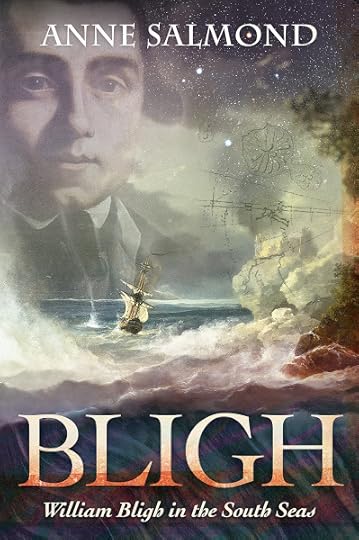 Anne Salmond (1945- ): Bligh (2011)
Anne Salmond (1945- ): Bligh (2011)Anne Salmond. Bligh: William Bligh in the South Seas. Viking. Auckland: Penguin Group (NZ), 2011.
I conclude with the latest major contribution to the Bounty story. Having written about Captain Cook in The Trial of the Cannibal Dog, and Tahiti in Aphrodite's Island, Pacific historian and anthropologist Anne Salmond felt ready to take on the equally formidable subject of Captain Bligh.
If the result isn't quite so satisfactory as her two previous histories, that's perhaps because her methods seem less surprising here than they were in (particularly) the Captain Cook book.
It's hard to know what remains to be said on the subject. It was all a long time ago. It cast a long shadow over everyone involved - and the horrific 2004 sex scandals on Pitcairn Island unfortunately revealed that life there is no more idyllic now than it was in the immediate aftermath of the Mutiny.
•
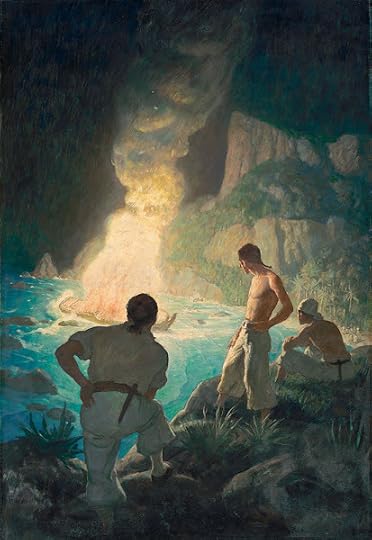 N. C. Wyeth: The Burning of the "Bounty" (1940)
N. C. Wyeth: The Burning of the "Bounty" (1940)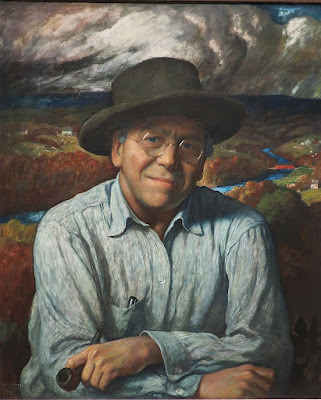 N. C. Wyeth (1882-1945): Self-portrait (1940)
N. C. Wyeth (1882-1945): Self-portrait (1940)•
Published on October 12, 2024 14:25
September 23, 2024
HAUNTS Launch / Emma Smith Exhibition - 5-6/10/24
 Emma Smith: "The second sun" (The Municipal Gardens, 2024)
Emma Smith: "The second sun" (The Municipal Gardens, 2024)[images courtesy of the artist]
Bronwyn Lloyd will be hosting an exhibition
of recent paintings
by Emma Smith
at 6 Hastings Road
Mairangi Bay, Auckland
Saturday-Sunday 5-6 October
from 11am-4pm
Jack Ross's new collection of stories
Haunts (Lasavia Publishing)
will be launched on the Saturday at 2pm
$30 cash or bank deposit (no EFTPOS)
ALL WELCOME
Refreshments provided
updates on Instagram: @lloyd.bronwyn
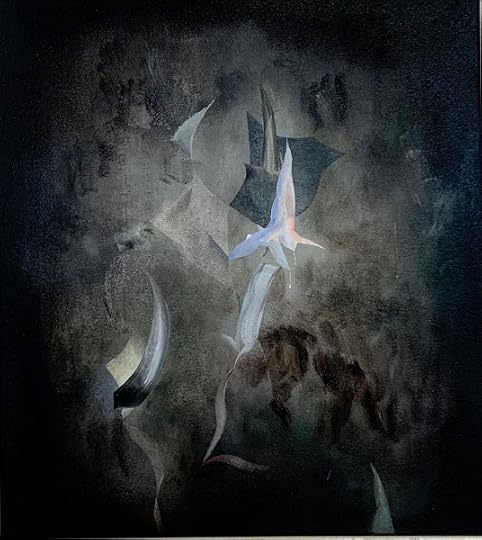 Emma Smith: "Living with caves" (The Municipal Gardens, 2024)
Emma Smith: "Living with caves" (The Municipal Gardens, 2024)•
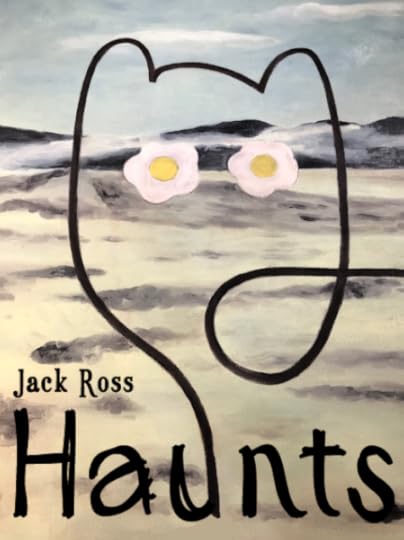 Haunts (Lasavia Publishing, 2024)
Haunts (Lasavia Publishing, 2024)Image: Graham Fletcher (by courtesy of the artist) / Design: Daniela Gast
Back cover blurb:What do we actually mean by the word haunt? In this new set of stories inspired by the term, Jack Ross invokes a series of his favourite haunts via voices from the past, beginning with Samuel Butler’s Erewhon and concluding with Emanuel Swedenborg.
In between he visits with Irish ghost-story maestro Joseph Sheridan Le Fanu, along with others ranging from James Joyce to H. P. Lovecraft – not to mention Scheherazade herself, creator / narrator of The 1001 Nights.
Most importantly of all, perhaps, he tries to settle accounts with his own father, the architect of a vast entangled empire of native bush and weeds at the back of their suburban quarter-acre section in Mairangi Bay.
The book ends with the novella Cartographies of the Afterlife, an exploration of the penumbra between life and death, based on accounts from recent visitors.
In the immortal words of Bette Davis: ‘Fasten your seatbelts, it's going to be a bumpy night.’
Jack Ross is the author of six poetry collections, four novels, and four books of short fiction. His previous collection, Ghost Stories (Lasavia, 2019), has been prescribed for writing courses at three local universities. He’s also edited numerous books, anthologies, and literary journals, including (most recently) Mike Johnson’s Selected Poems (2023).
•
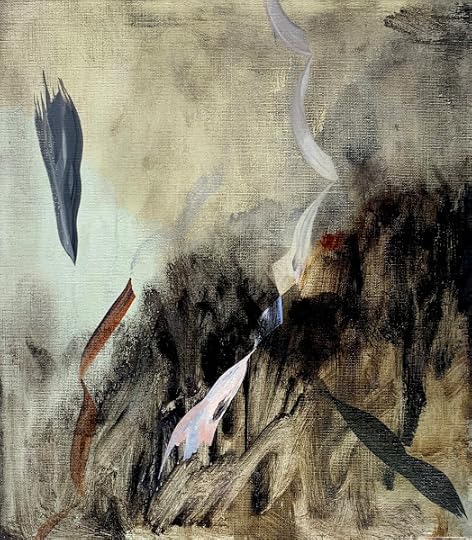 Emma Smith: "The second to last" (The Municipal Gardens, 2024)
Emma Smith: "The second to last" (The Municipal Gardens, 2024)
Artist's statement:'Years ago, I lived in a downstairs flat with wide windows that let the night right into the room. There were white datura flowers with pink throats on the fence line. They hummed at dusk. For a long time I tried to paint them as they seemed utterly their own thing. The blooms became sails, became tents, ripped tarps, ropes whipping, planes noses, thick smoke, drones, white flags, stadium lights, search lights, anxious lanterns, distant fires, phosphorescence from below. These shapes still resist a final form and so too do the conditions about them. They are in scorched fields, floating in the dead air of space and falling in fiery plumes.’
Emma Smith was born in Tāmaki Makaurau, Aotearoa/ New Zealand in 1975. Smith currently teaches Contemporary Arts at Unitec Institute of Technology, Auckland. Further information can be found at her website https://emmasmithtingrew.wordpress.com/.
•
Published on September 23, 2024 12:10
September 10, 2024
6X10 Poetry Event, Avondale 28/9/24 @ 7 for 7.30 pm
 Whau Arts Festival (21 September - 3 October 2020)
Whau Arts Festival (21 September - 3 October 2020)•
Whau Arts Festival
6X10 Poetry Event
All Goods Community Arts Space
99 Rosebank Road, Avondale
(Behind the Public Library)
MC: Bronwyn Bent
Whau The People
Festival Organiser
Janet Charman
Stu Bagby
Anne Kennedy
Elizabeth Morton
Jack Ross
Leilani Tamu
Saturday September 28 @7 for 7.30 pm
•
 Janet Charman
Janet Charman Stu Bagby
Stu Bagby Anne Kennedy
Anne Kennedy Elizabeth Morton
Elizabeth Morton Jack Ross
Jack Ross Leilani Tamu
Leilani Tamu•
 All Goods Community Arts Space (Avondale)
All Goods Community Arts Space (Avondale)
•
Published on September 10, 2024 14:36
August 20, 2024
Byzantium
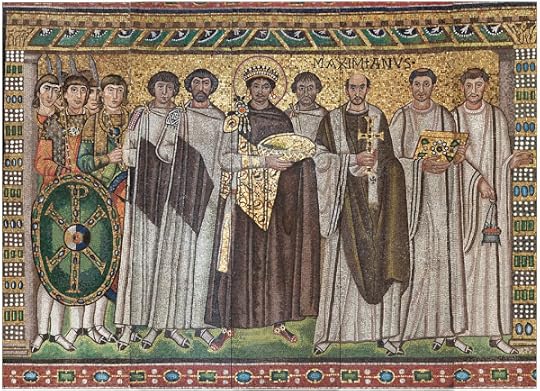 San Vitale, Ravenna: The Emperor Justinian and his Court (c. 547 CE)
San Vitale, Ravenna: The Emperor Justinian and his Court (c. 547 CE)
The unpurged images of day recede;
The Emperor's drunken soldiery are abed;
Night resonance recedes, night-walkers' song
After great cathedral gong;
A starlit or a moonlit dome disdains
All that man is,
All mere complexities,
The fury and the mire of human veins.
- W. B. Yeats, "Byzantium" (1932)
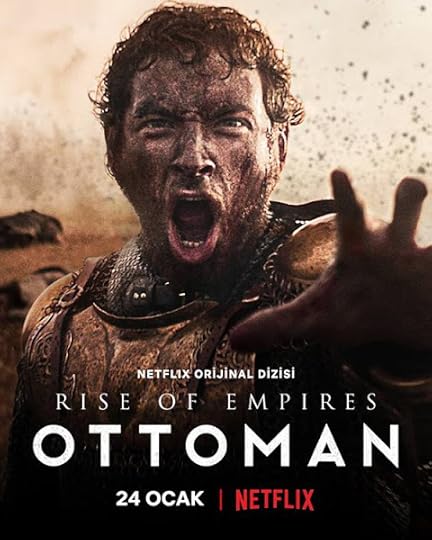 Rise of Empires: Ottoman: The Fall of Constantinople (2020)
Rise of Empires: Ottoman: The Fall of Constantinople (2020)Every now and then you run across a genuinely exciting documentary series on Netflix. One such was " Age of Samurai: Battle for Japan " (2021), a dramatic and informative - albeit blood-soaked - account of the unification of Japan by various warring daimyō (or clan-lords) over the period from 1551 to 1616.
Another was " Rise of Empires: Ottoman ." The first series of this Turkish docudrama told the story of the siege and fall of Constantinople in 1453. The second - even more gripping, if somewhat gruesome - instalment of six episodes outlined the bloody conflict between Sultan Mehmed the Conqueror and his childhood companion Vlad the Impaler, culminating in the 1462 Ottoman invasion of Wallachia.
If you want to know who a bit more about Vlad than the fact that he was the original for Bram Stoker's Count Dracula, this is the place to go. Trigger Alert: if anything, he was even more terrifying in the flesh than in fiction ...
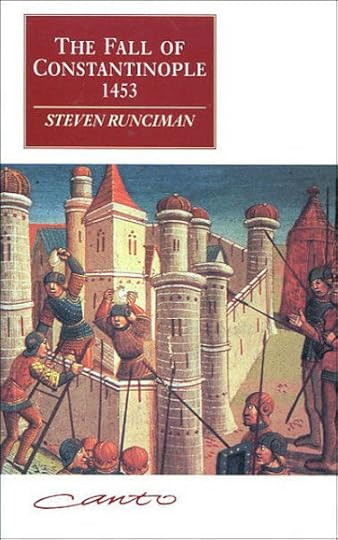 Steven Runciman: The Fall of Constantinople 1453 (1965)
Steven Runciman: The Fall of Constantinople 1453 (1965)Steven Runciman. The Fall of Constantinople 1453. 1965. Cambridge University Press. London: Readers Union Ltd., 1966.The other day I picked up a copy of Steven Runciman's classic account of the siege, The Fall of Constantinople. Sir Steven Runciman (1903-2000), one of the strangest people ever to adorn the profession of history, specialised in the subject of the Eastern Roman empire before and after the era of the Crusades, as you'll discover if you look into the pages of his biography, Outlandish Knight:
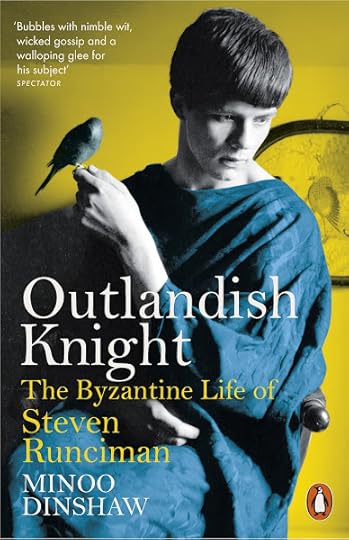 Minoo Dinshaw: Outlandish Knight (2017)
Minoo Dinshaw: Outlandish Knight (2017)Minoo Dinshaw. Outlandish Knight: The Byzantine Life of Steven Runciman. 2016. Penguin Books. London: Penguin Random House UK, 2017.His magnum opus, the three-volume History of the Crusades (1951-54), remains the most elegant and lapidary account of the period despite the seventy years that have passed since its appearance.
 Steven Runciman: The History of the Crusades (3 vols: 1951-54)
Steven Runciman: The History of the Crusades (3 vols: 1951-54)Steven Runciman. A History of the Crusades. 3 vols. 1951-54. Peregrine Books. Harmondsworth: Penguin, 1965.The First Crusade and the Foundation of the Kingdom of Jerusalem (1951)The Kingdom of Jerusalem and the Frankish East, 1100-1187 (1952)The Kingdom of Acre and the Later Crusades (1954)Admittedly, it has its rivals. Notably, a spirited single-volume account of the first three Crusades by the almost equally eccentric and glamorous Russian-French novelist-historian Zoë Oldenbourg.
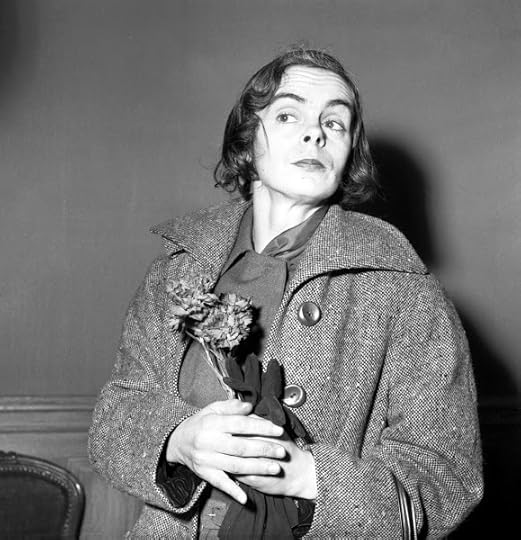 Zoë Oldenbourg (1916–2002)
Zoë Oldenbourg (1916–2002)Zoë Oldenbourg. The Crusades. 1965. Trans. Anne Carter. Pantheon Books. New York: Random House, Inc., 1966.The question remains: what is it about Byzantium? Why does it arouse such intense passions in people even now, nearly six centuries after its fall?
I suppose it might be because it still remains a bit of an unknown quantity for most readers. Rightly or wrongly, we all have some kind of mental image of the Romans and their Empire (slaves, togas, the forum, the legions, SPQR).
We also have certain select vignettes of the Ancient Greeks: Socrates and Plato arguing in the agora at Athens, swift Greek triremes defeating the Persian fleet at Salamis - even, perhaps, the last stand of the 300 at Thermopylae ...
Or perhaps you prefer Lord Byron?
Tell them in Sparta, passer-by
That here, obedient to their will, we lie.
- Simonides of Ceos
The mountains look on Marathon —
And Marathon looks on the sea;
And musing there an hour alone,
I dream’d that Greece might still be free;
For standing on the Persians’ grave,
I could not deem myself a slave.
- "The Isles of Greece"
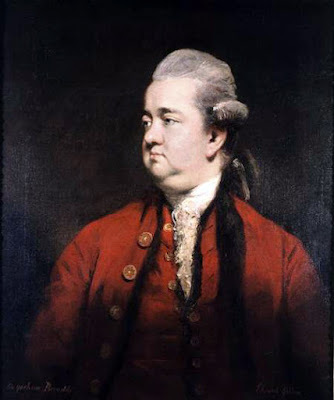 Joshua Reynolds: Edward Gibbon (1737-1794)
Joshua Reynolds: Edward Gibbon (1737-1794)Edward Gibbon. The History of the Decline & Fall of the Roman Empire. 1776-88. Ed. Betty Radice & Felipé Fernández-Armesto. 8 vols. London: Folio Society, 1983-90.The Turn of the Tide (1983)Constantine and the Roman Empire (1984)The Revival and Collapse of Paganism (1985)The End of the Western Empire (1986)Justinian and the Roman Law (1987)Mohammed and the Rise of the Arabs (1988)The Normans in Italy and the Crusades (1989)The Fall of Constantinople and the Papacy in Rome (1990)But what about Constantinople and the Byzantine Empire? It doesn't help that the most celebrated historian to have written on the subject, Edward Gibbon, had an intense prejudice against the Byzantines, and seized every possible chance to disparage them in his epic, immensely influential history of the long decline of Rome and its empire.
Nor has anything comparable been written in their defence. W. B. Yeats adored them, of course. I quoted above from his great poem "Byzantium", but there's also the earlier "Sailing to Byzantium" (1927) to consider:
Once out of nature I shall never take
My bodily form from any natural thing,
But such a form as Grecian goldsmiths make
Of hammered gold and gold enamelling
To keep a drowsy Emperor awake;
Or set upon a golden bough to sing
To lords and ladies of Byzantium
Of what is past, or passing, or to come.
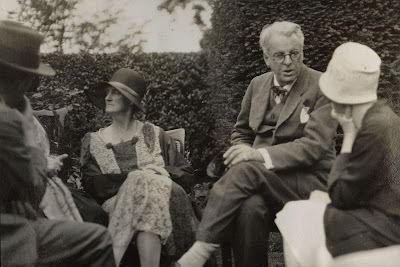 Lady Ottoline Morrell: Yeats at Garsington (1930)
Lady Ottoline Morrell: Yeats at Garsington (1930)[l-to-r: Walter de la Mare, Georgie Yeats, W. B. Yeats, unknown]
Yeats was, admittedly, a bit of a weirdo. He spent much of his youth studying magic with the self-appointed Magi of the Hermetic Order of the Golden Dawn, but it was the spirit messages he received at a series of séances with his newly married wife Georgie Hyde-Lees on their honeymoon which inspired him to construct a whole theory of history based on repeating cycles (or "gyres").
This led him to the conclusion that medieval Byzantium was the apex of all human cultures, and - presumably - to his (alleged) desire to spend eternity as a golden clockwork bird on a tree-branch.
These ideas also led him to write great, resonant poems, such as "The Second Coming" ("what rough beast, its hour come round at last, / Slouches towards Bethlehem to be born?"). Beyond that, though, it's hard to say to what degree he actually believed in his theories, despite the immense detail devoted to the subject in his prose work A Vision (1925 / 1937).
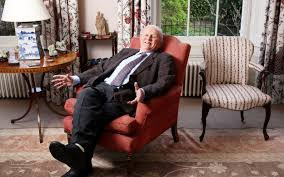 Clara Molden: John Julius Norwich (1929-2018)
Clara Molden: John Julius Norwich (1929-2018)John Julius Norwich. A History of Byzantium. 3 vols. 1988-1995. Harmondsworth: Penguin, 1990-1996.The Early Centuries (1988)The Apogee (1991)The Decline and Fall (1995)It wasn't, in fact, until the last decades of the twentieth century that Byzantium received anything like the historical treatment it deserved. Popular historian John Julius Norwich decided to bite the bullet and try to produce a three-volume history to stand alongside Runciman's earlier work on the Crusades.
Did it redress the balance? Not really, no. Norwich is no Runciman. But he's a very accessible writer, who's written illuminating books about Venice, the Norman conquest of Sicily, and a variety of other Mediterranean events and personages. His history of Byzantium (also available in abridged form in a single volume) is a fine addition to the bibliography of the subject.
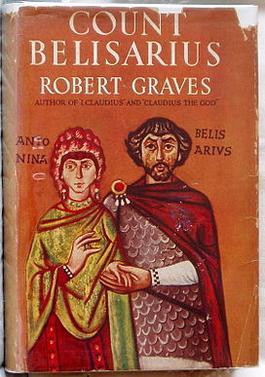 Robert Graves: Count Belisarius (1938)
Robert Graves: Count Belisarius (1938)Robert Graves. Count Belisarius. 1938. London: Cassell & Co. Ltd., 1962.Which is, of course, immense. In fact, so many books touch on various aspects of Imperial Byzantium's thousand-year history, that it can be hard to know where to begin.
If in doubt, start off with an historical novel can be good advice on such occasions. After the immense success of I, Claudius (1934) and Claudius the God (1935), maverick English poet Robert Graves attempted to repeat the trick with a book about the great Byzantine general Belisarius (500–565).
Just as the Claudius books were largely based on the surviving writings of Roman historians Suetonius and Tacitus, so this new one was inspired by Procopius's History of Justinian's Wars and Secret History.
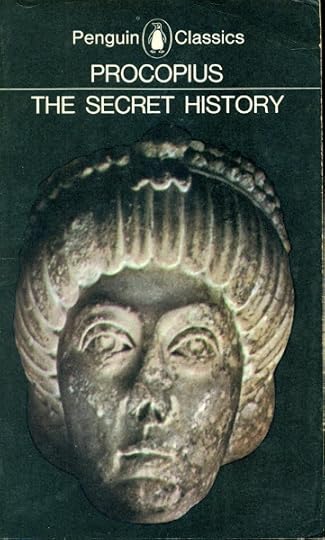 Procopius: The Secret History (1966)
Procopius: The Secret History (1966)Procopius. Works. Trans. H. B. Dewing, with Glanville Downey. 7 vols. 1914-1940. Loeb Classics. London: William Heinemann / Cambridge: Harvard University Press, 1968, 1969, 1971, 1978 & 1979.History of the Wars, Books I & II. Trans. H. B. Dewing. 1914 (1979)History of the Wars, Books III & IV. Trans. H. B. Dewing. 1916 (1979)History of the Wars, Books V & VI. Trans. H. B. Dewing. 1919 (1968)History of the Wars, Books VI.16-VII.35. Trans. H. B. Dewing. 1924 (1979)History of the Wars, Books VII.36-VIII. Trans. H. B. Dewing. 1928 (1978)The Anecdota or Secret History. Trans. H. B. Dewing. 1935 (1969)Buildings / General Index to Procopius. Trans. H. B. Dewing, with Glanville Downey. 1940 (1971)Procopius is unique among Classical historians in that as well as writing a long, tediously official history of Justinian's wars in Persia and Italy, he also left behind a scurrilous volume of scandalous gossip about the Emperor Justinian and his wife Theodora - allegedly a circus performer and even prostitute before she became an Empress - the Secret History.
Graves takes full advantage of this material, and compiles a spirited yarn about the virtuous Belisarius, betrayed by his own wife Antonina as well as the corrupt Imperial couple who employed him to clean up their mistakes for so long.
Is Procopius's backstairs gossip all true? Who knows? Perhaps not the stuff about Justinian transforming into a hairy demon when he thought he was unobserved - but a lot of the rest sounds uncomfortably plausible. However, some contemporary historians have advanced a rather different reading of the Secret History:
... it has been argued that Procopius prepared the Secret History as an exaggerated document out of fear that a conspiracy might overthrow Justinian's regime, which — as a kind of court historian — might be reckoned to include him. The unpublished manuscript would then have been a kind of insurance, which could be offered to the new ruler as a way to avoid execution or exile after the coup. If this hypothesis were correct, the Secret History would not be proof that Procopius hated Justinian or Theodora. - Wikipedia: ProcopiusSpeaking for myself, that sounds to me like one of those perverse hypotheses historians like dreaming up to avoid the obvious conclusions already sanctioned by other scholars - a bit like the one about how the poet Ovid just pretended to have been banished to the Black Sea by the Emperor Augustus, but instead just sat in his house at Rome and wrote poems about being in exile.
In other words, given the tone of his invective, the chances that the author of the Secret History actually admired Justinian and Theodora are about as likely - in my humble opinion - as the possibility that Q-Anon was actually right about Pizzagate, and Donald Trump really was divinely ordained to combat demon worship in Washington D.C.
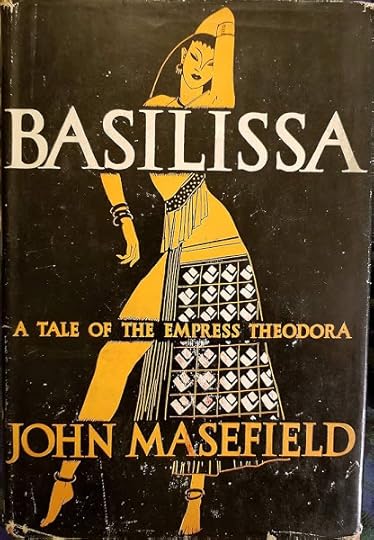 John Masefield: Basilissa: A Tale of the Empress Theodora (1938)
John Masefield: Basilissa: A Tale of the Empress Theodora (1938)John Masefield. Byzantine Trilogy. London: William Heinemann, Ltd., 1940-47.Basilissa: A Tale of the Empress Theodora (1940)Conquer: A Tale of the Nika Rebellion in Byzantium (1941)Badon Parchments (1947)Mind you, Justinian and Theodora do have their admirers. British Poet Laureate John Masefield, in his two historical novels Basilissa and Conquer, portrayed the Empress Theodora as a kind of distant cousin of Wallis Simpson - a potential breath of fresh air for a moribund court and royal family. She can do little wrong in his eyes (though Justinian does come across as a bit of a wimp).
The final volume in his trilogy (and the last novel he ever wrote), Badon Parchments, presents the story of King Arthur's victory over the Saxons at Mons Badonicus through the eyes of some official Byzantine observers, sent by the authorities of the Eastern Empire to observe, and - if possible - encourage this new manifestation of Roman fighting spirit.
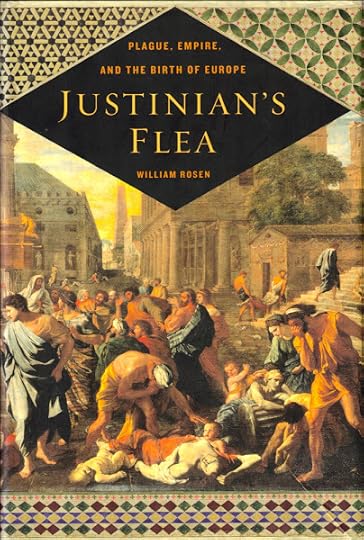 William Rosen: Justinian's Flea (2006)
William Rosen: Justinian's Flea (2006)William Rosen. Justinian’s Flea: Plague, Empire and The Birth of Europe. 2006. London: Pimlico, 2008.A no less absorbing, and considerably more accurate picture of the Byzantine Empire at its apogee under Justinian, is given by William Rosen's account of one of the very worst outbreaks of plague ever to afflict the human race - and its possible influence on both the rise of Islam and of an independent Europe.
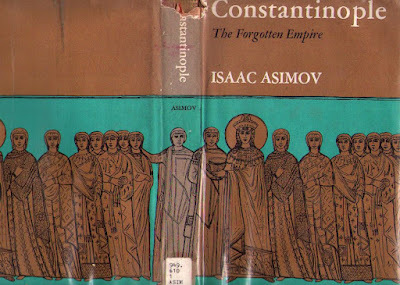 Isaac Asimov: Constantinople: The Forgotten Empire (1970)
Isaac Asimov: Constantinople: The Forgotten Empire (1970)Isaac Asimov. Constantinople: The Forgotten Empire. Boston: Houghton Mifflin Company, 1970.However, if that sounds like a bit of a fun bypass, you could do worse than check out either SF writer Isaac Asimov's focussed and informative short history of the "Forgotten Empire", or - for a more recent view - Aussie Radio personality Richard Fidler's travel book Ghost Empire.
Fidler attempts to recount certain picturesque events from the history of Byzantium in a series of rather stilted dialogues with his young son. It's a surprisingly successful formula, and gives a good basis for further reading - just like its even more beguiling follow-up Saga Land (2017), about the wondrous world of the Icelandic Sagas.
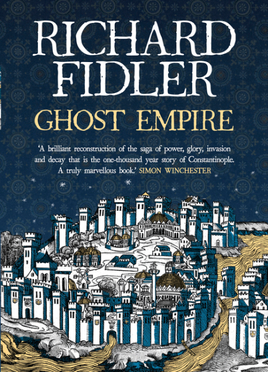 Richard Fidler: Ghost Empire (2016)
Richard Fidler: Ghost Empire (2016)Richard Fidler. Ghost Empire. 2016. ABC Books. Sydney: HarperCollins Publishers Australia Pty Ltd., 2017.
•
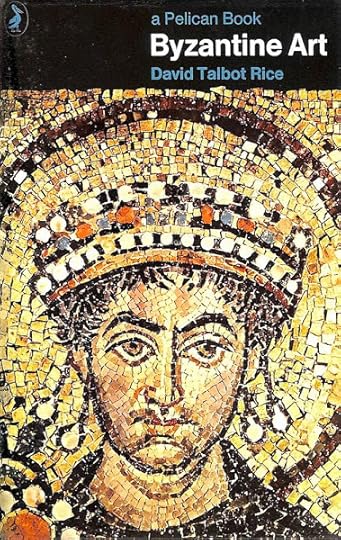 David Talbot Rice: Byzantine Art (1968)
David Talbot Rice: Byzantine Art (1968)(1929-2018) (1916–2002) (1903-2000)
Books I own are marked in bold:
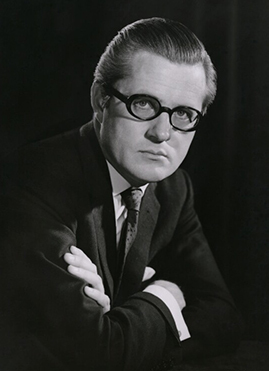 John Julius Norwich (1929-2018)
John Julius Norwich (1929-2018)[John Julius Cooper, 2nd Viscount Norwich]
(1929–2018)
[with Reresby Sitwell] Mount Athos (1966)The Normans in the South, 1016–1130 [aka 'The Other Conquest'] (1967)Included in: The Normans in Sicily: The Normans in the South, 1016-1130 & The Kingdom in the Sun, 1130-1194. 1967 & 1970. Harmondsworth: Penguin, 1992. Sahara (1968)The Kingdom in the Sun, 1130–1194 (1970)Included in: The Normans in Sicily: The Normans in the South, 1016-1130 & The Kingdom in the Sun, 1130-1194. 1967 & 1970. Harmondsworth: Penguin, 1992. Great Architecture of the World (1975)Venice: The Rise to Empire (1977)Included in: A History of Venice. 1977 & 1981. Harmondsworth: Penguin, 2003. Venice: The Greatness and Fall (1981)Included in: A History of Venice. 1977 & 1981. Harmondsworth: Penguin, 2003. A History of Venice (1982)A History of Venice. 1977 & 1981. Harmondsworth: Penguin, 2003. [with Suomi La Valle] Hashish (1984)The Architecture of Southern England (1985)Fifty Years of Glyndebourne (1985)A Taste for Travel (1985)Byzantium: The Early Centuries (1988)Byzantium: The Early Centuries. 1988. Harmondsworth: Penguin, 1990. The Normans in Sicily (1992)The Normans in Sicily: The Normans in the South, 1016-1130 & The Kingdom in the Sun, 1130-1194. 1967 & 1970. Harmondsworth: Penguin, 1992. Byzantium; vol. 2: The Apogee (1992)Byzantium: The Apogee. 1991. Harmondsworth: Penguin, 1993. Byzantium; vol. 3: The Decline and Fall (1995)Byzantium: The Decline and Fall. 1995. Harmondsworth: Penguin, 1996. A Short History of Byzantium (1997)[with Quentin Blake] The Twelve Days of Christmas (1998)Shakespeare's Kings: the Great Plays and the History of England in the Middle Ages: 1337–1485 (2000)Paradise of Cities, Venice and its Nineteenth-century Visitors (2003)Paradise of Cities: Nineteenth-century Venice Seen through Foreign Eyes. London: Viking, 2003. The Middle Sea: A History of the Mediterranean (2006)The Middle Sea: A History of the Mediterranean. 2006. London: Vintage Books, 2007. Trying to Please [autobiography] (2008)The Popes: A History [aka 'Absolute Monarchs: A History of the Papacy'] (2011)A History of England in 100 Places: From Stonehenge to the Gherkin (2012)Sicily: An Island at the Crossroads of History (2015)Four Princes: Henry VIII, Francis I, Charles V, Suleiman the Magnificent and the Obsessions that Forged Modern Europe (2016)Four Princes: Henry VIII, Francis I, Charles V, Suleiman the Magnificent and the Obsessions that Forged Modern Europe. London: John Murray (Publishers), 2016. France: A History: from Gaul to de Gaulle [aka 'A History of France'] (2018)
Edited:
Christmas Crackers: Being Ten Commonplace Selections 1970-1979 (1980)Britain's Heritage (1983)The Italian World: History, Art and the Genius of a People (1983)More Christmas Crackers, 1980-1989 (1990)Oxford Illustrated Encyclopaedia of Art (1990)Venice: a Traveller's Companion (1990)Still More Christmas Crackers, 1990-1999 (2000)Treasures of Britain (2002)The Duff Cooper Diaries (2006)The Great Cities in History (2009)The Big Bang: Christmas Crackers, 2000–2009 (2010)Darling Monster: The Letters of Lady Diana Cooper to Her Son John Julius Norwich (2013)[with Quentin Blake] The Illustrated Christmas Cracker (2013)Cities That Shaped the Ancient World (2014)A Christmas Cracker: being a Commonplace Selection (2018)
•
 Zoë Oldenbourg
Zoë Oldenbourg[Зоя Сергеевна Ольденбург]
(1916–2002)
Fiction:
Argile et cendres (1946)The World is Not Enough. 1946. Trans. Willard A. Trask. 1948. Harmondsworth: Penguin, 1964. La Pierre angulaire (1953)The Cornerstone. 1953. Trans. Edward Hyams. London: Victor Gollancz Ltd., 1954. Réveillés de la vie (1956)The Awakened. Trans. Edward Hyams (1957) Les Irréductibles (1958)The Chains of Love. 1958. Trans. Michael Bullock. London: Victor Gollancz Ltd., 1959. Les Brûlés (1960)Destiny of Fire. 1960. Trans. Peter Green. 1961. Harmondsworth: Penguin, 1969. Les Cités charnelles, ou L'Histoire de Roger de Montbrun (1961)Cities of the Flesh, or The Story of Roger de Montbrun. Trans. Anne Carter (1962) La Joie des pauvres (1970)The Heirs of the Kingdom. 1970. Trans. Anne Carter. 1971. Fontana Books. London: Wm. Collins., 1974. La Joie-souffrance (1980)Le Procès du rêve (1982)Les Amours égarées (1987)Déguisements [short stories] (1989)
Non-fiction:
Le Bûcher de Montségur, 16 mars 1244 (1959)Massacre at Montségur: A History of the Albigensian Crusade. 1959. Trans. Peter Green. 1961. Phoenix Giant. London: Orion Books Ltd., 1998. Les Croisades (1965)The Crusades. 1965. Trans. Anne Carter. Pantheon Books. New York: Random House, Inc., 1966. Catherine de Russie (1966)Catherine the Great. 1966. Trans. Anne Carter. Preface by Arthur Calder-Marshall. Women Who Made History. Geneva: Heron Books, 1968. Saint Bernard (1970)L'Épopée des cathédrales (1972)Que vous a donc fait Israël ? (1974)Visages d'un autoportrait (1977)Que nous est Hécube ?, ou Un plaidoyer pour l'humain (1984)
Plays:
L'Évêque et la vieille dame, ou La Belle-mère de Peytavi Borsier, pièce en dix tableaux et un prologue (1983)Aliénor, pièce en quatre tableaux (1992)
•
Sir Steven Runciman (1903-2000)
[Sir James Cochran Stevenson Runciman]
(1903-2000)
The Emperor Romanus Lecapenus and His Reign: A Study of Tenth-Century Byzantium (1929)A History of the First Bulgarian Empire (1930)Byzantine Civilization (1933)The Medieval Manichee: A Study of the Christian Dualist Heresy (1947)A History of the Crusades, Volume One (1951)A History of the Crusades. Vol. 1: The First Crusade and the Foundation of the Kingdom of Jerusalem. 1951. Peregrine Books. Harmondsworth: Penguin, 1965. A History of the Crusades, Volume Two (1952)A History of the Crusades. Vol. 2: The Kingdom of Jerusalem and the Frankish East, 1100-1187. 1952. Peregrine Books. Harmondsworth: Penguin, 1965. A History of the Crusades, Volume Three (1954)A History of the Crusades. Vol. 3: The Kingdom of Acre and the Later Crusades. 1954. Peregrine Books. Harmondsworth: Penguin, 1965. The Eastern Schism (1955)The Eastern Schism: a Study of the Papacy and the Eastern Churches during the 11th and 12th Centuries. 1955. Panther History. London: Panther, 1970. The Sicilian Vespers (1958)The Sicilian Vespers: A History of the Mediterranean World in the Later Thirteenth Century. 1958. A Pelican Book. Harmondsworth: Penguin, 1960. The White Rajahs: A History of Sarawak from 1841 to 1946 (1960)The Fall of Constantinople 1453 (1965)The Fall of Constantinople 1453. 1965. Cambridge University Press. London: Readers Union Ltd., 1966. The Great Church in Captivity: A Study of the Patriarchate of Constantinople from the Eve of the Turkish Conquest to the Greek War of Independence (1968)The Last Byzantine Renaissance (1970)Orthodox Churches and the Secular State (1971)Byzantine Style and Civilization (1975)The Byzantine Theocracy: The Weil Lectures, Cincinnati (1977)Mistra: Byzantine Capital of the Peloponnese (1980)The First Crusade (1980)A Traveller's Alphabet: Partial Memoirs (1991) ISBN 9780500015049
Secondary:
Dinshaw, Minoo. Outlandish Knight: The Byzantine Life of Steven Runciman. 2016. Penguin Books. London: Penguin Random House UK, 2017.
•
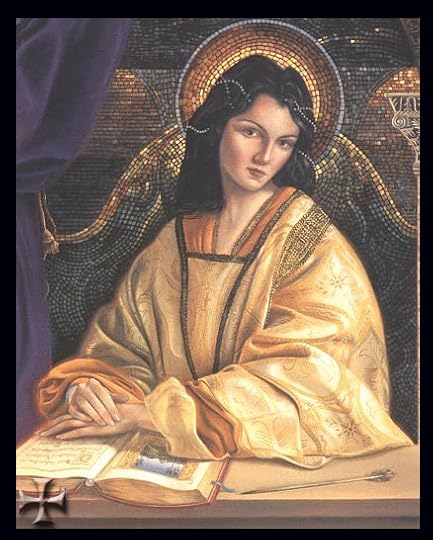 Anna Komnene (1083-1153 CE)
Anna Komnene (1083-1153 CE)Anna Komnēnē [Comnena] (1083–1153)
The Alexiad. Trans. E. R. A. Sewter. Penguin Classics. Harmondsworth: Penguin, 1969.
Procopius of Caesarea (c.500–c.565)
Works. Trans. H. B. Dewing, with Glanville Downey. 7 vols. 1914-1940. Loeb Classics. London: William Heinemann / Cambridge: Harvard University Press, 1968, 1969, 1971, 1978 & 1979.History of the Wars, Books I & II. Trans. H. B. Dewing. 1914 (1979)History of the Wars, Books III & IV. Trans. H. B. Dewing. 1916 (1979)History of the Wars, Books V & VI. Trans. H. B. Dewing. 1919 (1968)History of the Wars, Books VI.16-VII.35. Trans. H. B. Dewing. 1924 (1979)History of the Wars, Books VII.36-VIII. Trans. H. B. Dewing. 1928 (1978)The Anecdota or Secret History. Trans. H. B. Dewing. 1935 (1969)Buildings / General Index to Procopius. Trans. H. B. Dewing, with Glanville Downey. 1940 (1971)The Secret History. Trans. G. A. Williamson. Penguin Classics. Harmondsworth: Penguin, 1966.The Secret History. c.550 CE. Trans. G. A. Williamson. 1966. Introduction by Philip Ziegler. London: The Folio Society, 1990.
Michael Psellos / Psellus (c.1017/18-c.1078)
Fourteen Byzantine Rulers: The Chronographia of Michael Psellus. Trans. E. R. A. Sewter. 1953. Penguin Classics. 1966. Harmondsworth: Penguin, 1979.
•
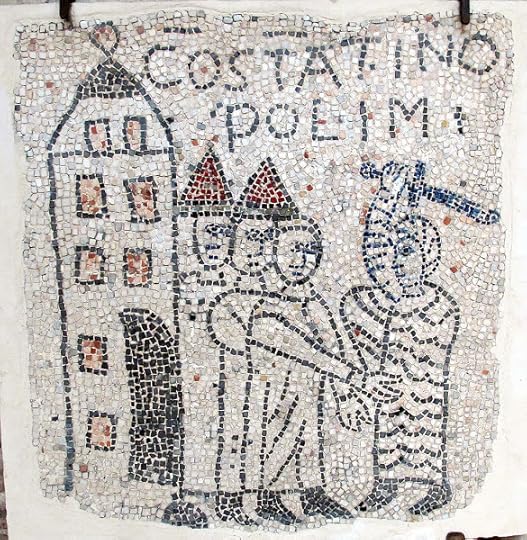 The Sack of Constantinople by the Crusaders (1204)
The Sack of Constantinople by the Crusaders (1204)Asimov, Isaac. Constantinople: The Forgotten Empire. Boston: Houghton Mifflin Company, 1970.Burckhardt, Jacob. The Age of Constantine the Great. 1852. Rev. ed. 1880. Trans. Moses Hadas. 1949. A Vintage Book V-393. New York: Random House, 1967.Byron, Robert. The Station. Athos: Treasures and Men. 1928. Introduction by Christopher Sykes. A Phoenix Press Paperback. London: The Orion Publishing Group Ltd., 2000.Byron, Robert. The Road to Oxiana. 1937. Introduction by Bruce Chatwin. London: Picador, 1981.Dalrymple, William. From the Holy Mountain: A Journey in the Shadow of Byzantium. 1997. Flamingo. London: HarperCollins Publishers, 1998.Fidler, Richard. Ghost Empire. 2016. ABC Books. Sydney: HarperCollins Publishers Australia Pty Ltd., 2017.Gibbon, Edward. The History of the Decline & Fall of the Roman Empire. 1776-88; 1910. Ed. Betty Radice & Felipé Fernández-Armesto. 8 vols. London: Folio Society, 1983-90.The Turn of the Tide. Ed. & with an introduction by Betty Radice (1983)Constantine and the Roman Empire. Ed. & with an introduction by Betty Radice (1984)The Revival and Collapse of Paganism. Ed. & with an introduction by Betty Radice (1985)The End of the Western Empire. Ed. & with an introduction by Betty Radice (1986)Justinian and the Roman Law. Ed. & with an introduction by Felipe Fernández-Armesto (1987)Mohammed and the Rise of the Arabs. Ed. & with an introduction by Felipe Fernández-Armesto (1988)The Normans in Italy and the Crusades. Ed. & with an introduction by Felipe Fernández-Armesto (1989)The Fall of Constantinople and the Papacy in Rome. Ed. & with an introduction by Felipe Fernández-Armesto (1990)Hodgkin, Thomas. The Barbarian Invasions of the Roman Empire. ['Italy and her Invaders,' 1880-1899]. Introduced by Peter Heather. 8 vols. London: The Folio Society, 2000-3.The Visigothic Invasion. 1880. rev. ed. 1892 (2000)The Huns and the Vandals. 1880. rev. ed. 1892 (2000)The Ostrogoths, 476-535. 1885. rev. ed. 1896 (2001)The Imperial Restoration, 535-553. 1885. rev. ed. 1896 (2001)The Lombard Invasion, 553-600. 1895 (2002)The Lombard Kingdom, 600-744. 1895 (2002)The Frankish Invasion, 744-774. 1899 (2003)The Frankish Empire. 1899 (2003)Hallam, Elizabeth, ed. Chronicles of the Crusades: Eye-Witness Accounts of the Wars Between Christianity and Islam. 1989. Godalming, Surrey: CLB International, 1997.Hill, Rosalind, ed. Gesta Francorum et Aliorum Hierosolimitanorum. Nelson’s Medieval Texts. London: Thomas Nelson & Sons, 1962.Joinville & Villehardouin. Chronicles of the Crusades: The Conquest of Constantinople / The Life of Saint Louis. Trans. M. R. B. Shaw. 1963. Penguin Classics. Harmondsworth: Penguin, 1969.Rice, David Talbot. Byzantine Art. 1935. A Pelican Book. 1954. Harmondsworth: Penguin, 1968.Rosen, William. Justinian’s Flea: Plague, Empire and The Birth of Europe. 2006. London: Pimlico, 2008.Wilmot-Buxton, E. M. The Story of the Crusades. 1910. Told Through the Ages. 1912. London: George G. Harrap & Co. Ltd., 1927.
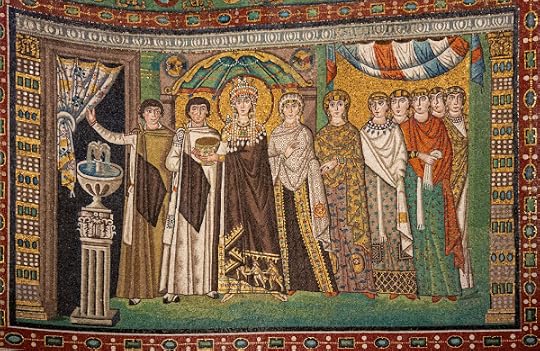 San Vitale, Ravenna: The Empress Theodora (c.540s CE)
San Vitale, Ravenna: The Empress Theodora (c.540s CE)•
Published on August 20, 2024 15:07
August 8, 2024
The Antikythera Conundrum
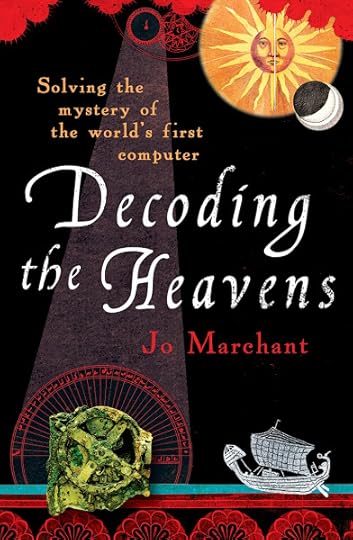 Jo Marchant: Decoding the Heavens (2008)
Jo Marchant: Decoding the Heavens (2008)Jo Marchant. Decoding the Heavens: Solving the Mystery of the World's First Computer. 2008. Windmill Books. London: The Random House Group Limited, 2009.The other day I ran across an interesting-looking book in one of the vintage shops I frequent. What's more, it appeared to have been signed by its author, presumably at some book festival or other, which added even further to its cachet.
Of course I'd heard of the Antikythera Mechanism. As I recall, it figured in an old episode of Arthur C. Clarke’s Mysterious World (1980), and since then it's been used as the principal plot point in the latest - hopefully last - Indiana Jones movie:
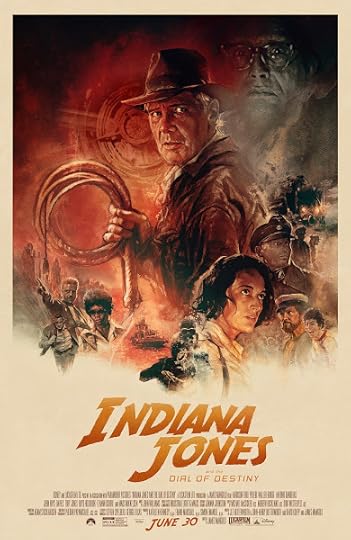 James Mangold, dir.: Indiana Jones and the Dial of Destiny (2023)
James Mangold, dir.: Indiana Jones and the Dial of Destiny (2023)The conceit there was that it was an Ancient Greek time machine, built by Archimedes of Syracuse, which some Nazi was trying to use to go back and change the course of history so that the Germans would win the Second World War.
As is so often the case, the truth in this case is far more interesting than the fiction. Jo Marchant and her publishers seem to have found it difficult to settle on a subtitle adequate to the significance of this artefact: "Decoding the Heavens: A 2,000-Year-old Computer and the Century Long Search to Discover Its Secrets" was the first one they came up with. The paperback edition simplified this to "Solving the Mystery of the World's First Computer."
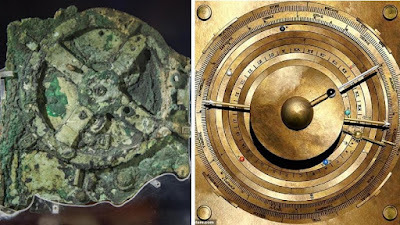 Digital replica of the Antikythera Mechanism (2021)
Digital replica of the Antikythera Mechanism (2021)Is it a computer? Well, that depends on what you mean by the term. Certainly it's an extremely complex calculating machine used - it would appear - to collate and chart astronomical phenomena. So, while it's an analogue rather than a digital device, the concensus of opinion seems to be that "computer" is indeed an appropriate description for it.
Jo Marchant, an award-winning science writer who also has a PhD in Microbiology, has put together a fascinating read. She charts the story of this strange piece of machinery from its recovery in 1901 from an Ancient Greek shipwreck off the island of Antikythera, to its present day place of honour in the National Archaeological Museum, Athens.
Like her predecessor in this particular subgenre, Dava Sobel in Longitude (1995), Marchant assembles a varied cast of heroes and villains along the way. Among the heroes are:
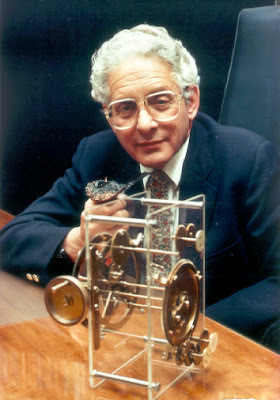 Derek J. de Solla Price (1922-1983)
Derek J. de Solla Price (1922-1983)Derek de Solla Price, who became interested in the mechanism in 1951, after it had been unearthed from the hiding place in which it was concealed during the Nazi occupation of Greece, and who made the first (approximate) reconstruction of it in the early 1970s.
 Michael T. Wright (1948- )
Michael T. Wright (1948- )Michael Wright, who, initially fascinated by Price's monograph Gears from the Greeks (1974), has worked on the mechanism ever since, creating a model in 2006 which is the most accurate so far, and which is now in the Athens museum.
So far so good. There's no doubt that both of these ingenious scholars deserve the warmest praise. Wright appears to have cooperated fully with Marchant's book, which earned him the following encomium in her acknowledgements:
I am greatly indebted to Michael Wright, a gentleman who fielded my never-ending questions with honesty and grace ...
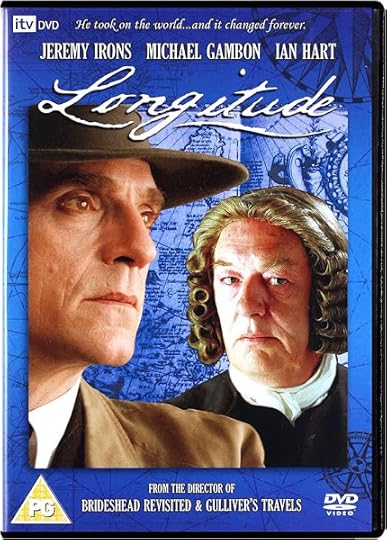 Charles Sturridge, dir. Longitude (2000)
Charles Sturridge, dir. Longitude (2000)Wright is, in effect, Marchant's equivalent to Dava Sobel's John Harrison (1693-1776), the working-class hero whose pioneering work on marine chronometers made possible the accurate determining of longitude at sea.
Unfortunately there's something about the Antikythera mechanism which seems to bring out the worst in people. It's a little like that fatal golden apple of discord inscribed "to the fairest," which led to the shepherd Paris having to make a choice between three contending goddesses, thus causing (inadvertently) the Trojan War.
If one continues reading the acknowledgments to Marchant's book, this is the next paragraph after the one about Michael Wright.
Thanks to Tony Freeth and his colleagues ... who were charming company and of great help when I first researched the Antikythera mechanism. Once I started writing this book, they felt unable to speak to me any further about their work or to be involved in any way. I hope I have done justice to their roles.
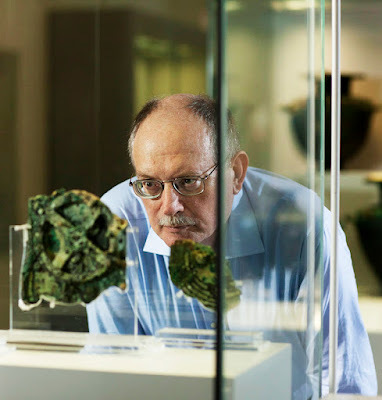 Tony Freeth
Tony FreethThis is an unfortunate admission. Dr Tony Freeth is a founding member of the Antikythera Mechanism Research Project and an Honorary Senior Research Associate at University College, London. Much of the more recent work on the mechanism has taken place under his auspices.
Nor did he agree that Marchant had "done justice" to his role in the reconstruction and study of this ancient orrery. As Wikipedia article on Marchant's book sums it up:
The author acknowledges ... that none of the principal researchers from the Antikythera Mechanism Research Project were involved "in any way" with the writing of the book. The project has published a commentary that sets out problems with the book's account of their work.The entry continues: "The book's account of the collaboration between Michael Wright and Allan Bromley is disputed."
 Allan G. Bromley (1948-2002)
Allan G. Bromley (1948-2002)This is another area of controversy in Marchant's book. Michael Wright collaborated with the late Australian academic Allan Bromley, an expert on Charles Babbage's calculating machines, in obtaining accurate X-ray pictures of the Antikythera mechanism in the Athens museum in the early 1990s. It's contended in Marchant's book that Allan Bromley unfairly monopolised these images, failing to grant access to Wright until shortly before Bromley's death from cancer in 2002.
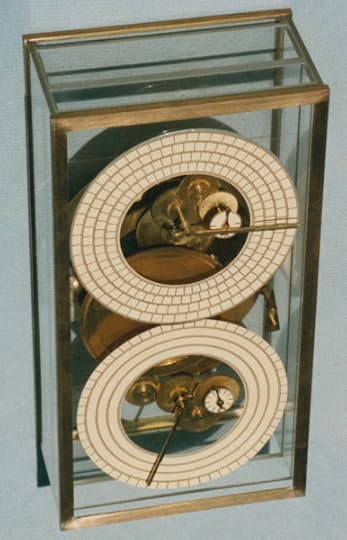 Allan Bromley & Frank Percival: Antikythera Mechanism Replica
Allan Bromley & Frank Percival: Antikythera Mechanism ReplicaThis is, to put it mildly, not how his widow sees it. As you'll see if you click on the following link, Anne Bromley objects strongly to the way in which her husband is portrayed in the book.
 Jo Marchant (1948-2002)
Jo Marchant (1948-2002)As a result of all this controversy, Jo Marchant decided to publish her own response to these criticisms:
It seems that Decoding the Heavens is causing some controversy on the web. In recent weeks, some of the researchers working on the Antikythera mechanism, as well as Anne Bromley (second wife of the late Allan Bromley, another Antikythera researcher) have posted comments expressing concern about the way that certain parts of the book are presented.Yes, that certainly resembles the "Apple of Discord" theory I outlined above. "Emotionally charged" is probably an understatement, in fact: the "comments" compiled by members of the Antikythera Mechanism Research Project run to 12 A4 pages! She goes on:
As you'll know if you have read Decoding the Heavens, the Antikythera mechanism is an emotionally-charged area of research. All of the researchers involved have devoted years if not decades of their lives to solving its mysteries, and that has resulted in a fair amount of passion and rivalry. In fact without those driving forces they probably wouldn't have reached such impressive results ...
But this also means that there are many disagreements between the various researchers regarding how different parts of the story unfolded, and where the credit for various different discoveries is due. I doubt that any single account could please everyone, but as a journalist I spoke at length to as many people as possible in order to reach my own careful and independent conclusions about what happened. In writing the book I've also tried to give a flavour of the various viewpoints, with different parts of the story seen through the eyes of different people, and it was important to me where possible to portray these scientists as human - reflecting their strengths and weaknesses rather than leaving them as bland, one-dimensional "heroes". I (and my publishers) stand by Decoding the Heavens as an honest and accurate account of the Antikythera story.My own impression as a reader is that her main cast is largely sorted into heroes (Price and Wright) and - if not outright villains, less than scrupulous rivals (Bromley and Freeth).
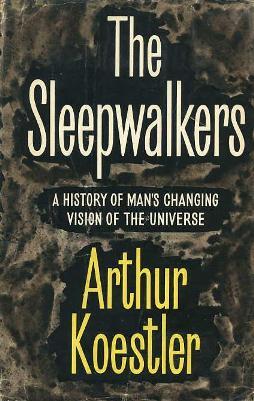 Arthur Koestler: The Sleepwalkers: A History of Man's Changing Vision of the Universe (1959)
Arthur Koestler: The Sleepwalkers: A History of Man's Changing Vision of the Universe (1959)But then, the same could be said of many successful pieces of scientific popularisation. Arthur Koestler's classic history of cosmology, The Sleepwalkers , for instance, makes no secret of his preference for Johannes Kepler over Galileo Galilei. The latter is portrayed as sly and intellectually dishonest, whereas Kepler's perplexities and contradictions are seen as signs of his immense and painful integrity.
It makes gripping reading, but could hardly be regarded as a definitive statement on the significance of the two in scientific history. The same (as I've mentioned above) is true of Dava Sobel's Longitude.
The majority of the researchers mentioned in the book are happy with the end result. But of course there are different perspectives and if you are interested in finding out about these then please do look at the comments from members of the Antikythera Mechanism Research Project. These researchers were very helpful and open when I first started reporting on the Antikythera mechanism, but I should note that after I told them in May 2007 that I planned to write a book, some members - Tony Freeth, Mike Edmunds, Yanis Bitsakis, Xenophon Moussas and John Seiradakis - declined to speak to me further ... They said that to do so would conflict with their own plans for Antikythera books and media projects.Fair enough. Marchant then goes on to mention some points which seem to her debatable: whose team it actually was, for instance: Freeth's or Mike Edmunds' ("This is technically correct ... but none of the sources I spoke to were in any doubt that Freeth was the real driving force behind the project"). She concludes: "I think though that most of the comments they have posted come down to differences in interpretation."
Tony Freeth was named to me as the AMRP team's spokesperson on any matters regarding Decoding the Heavens. I offered him the opportunity to comment on the two chapters regarding the team's work before publication but he declined, and in the nine months since the book came out, none of the team has mentioned any concerns about its content to either me or the publisher. I am sorry to hear at this stage that they believe there are inaccuracies, and any factual errors they raise now will of course be corrected in future reprints.
Regarding Anne Bromley's comments about the way her late husband is portrayed ... it was not my intention to describe him in a negative way, and I am genuinely surprised by her reaction. The impression I got of Allan Bromley during my research was of a brilliant, lively, forceful, friendly person, who could be manipulative and competitive at times, especially when it came to knowledge and information, but who got things done and was capable of sweeping others along with his enthusiasm. I hope this is the way he comes across in the book, and multiple sources who were close to Bromley in both the UK and Australia have said that they found my account reasonable and fair.That last sentence sounds like very sensible advice. Endless, after all, are the arguments of mages ...
It's good to see Decoding the Heavens provoking discussion though. Please do read the comments and make up your own minds.
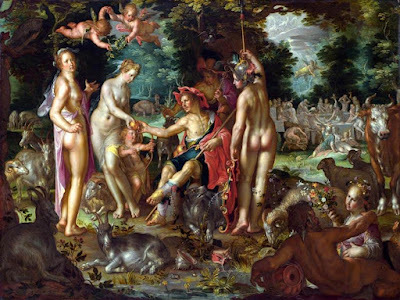 Joachim Wtewael: The Judgment of Paris (1615)
Joachim Wtewael: The Judgment of Paris (1615)•
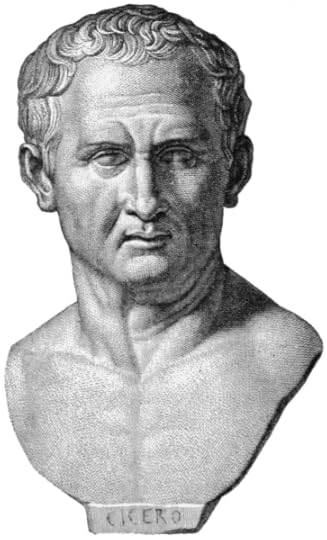 Marcus Tullius Cicero (106-43 BCE)
Marcus Tullius Cicero (106-43 BCE)In one of his philosophical dialogues, the Roman orator Cicero mentions two machines built by Archimedes which were brought back as booty by the Roman General Marcus Claudius Marcellus from the siege of Syracuse in 212 BCE. Unfortunately the Greek inventor himself was killed by a Roman legionary who'd been given orders to arrest him and bring him back to headquarters. So died one of the greatest minds of all time.
I had often heard this celestial globe or sphere mentioned on account of the great fame of Archimedes. Its appearance, however, did not seem to me particularly striking. ... But as soon as Gallus had begun to explain, by his sublime science, the composition of this machine, I felt that the Sicilian geometrician must have possessed a genius superior to any thing we usually conceive to belong to our nature. Gallus assured us, that the solid and compact globe, was a very ancient invention, and that the first model of it had been presented by Thales of Miletus. ... He added, that the figure of the sphere, which displayed the motions of the Sun and Moon, and the five planets, or wandering stars, could not be represented by the primitive solid globe. And that in this, the invention of Archimedes was admirable, because he had calculated how a single revolution should maintain unequal and diversified progressions in dissimilar motions. When Gallus moved this globe, it showed the relationship of the Moon with the Sun, and there were exactly the same number of turns on the bronze device as the number of days in the real globe of the sky. Thus it showed the same eclipse of the Sun as in the globe [of the sky], as well as showing the Moon entering the area of the Earth's shadow when the Sun is in line ...
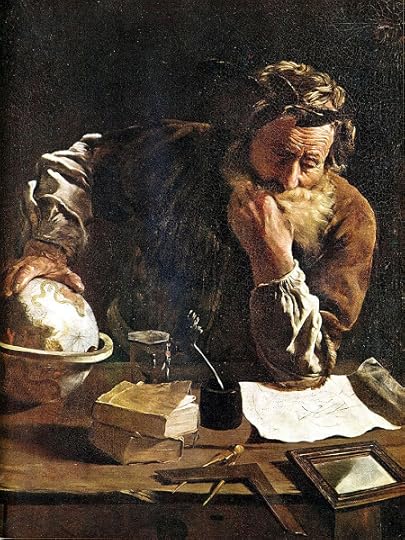 Dominico Fetti: Archimedes (1620)
Dominico Fetti: Archimedes (1620)It should be emphasised that this, the device described by Cicero, is certainly not that: the Antikythera mechanism. However, his remarks do confirm that such devices were known in the Ancient world, and that any attempts by earlier commentators to explain away the more complex features of this "celestial globe" as misunderstandings on the Roman lawyer's part can be now be seen to be completely misguided.
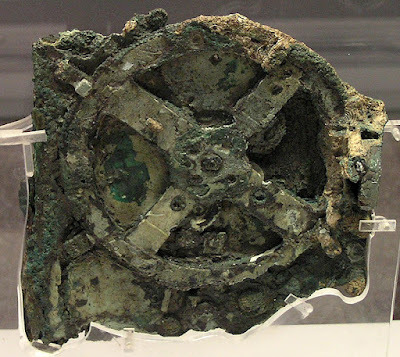 The Antikythera mechanism
The Antikythera mechanismThe vital significance of the Antikythera mechanism is that, while undoubtedly a wonderful piece of craftsmanship, it was not unique. The elaborate instructions included on it imply that it was meant for a less-then-expert recipient - some rich collector, perhaps, who wanted it to show off to his friends.
 Massimo Mogi Vicentini: The Antikythera Celestial Machine (2012)
Massimo Mogi Vicentini: The Antikythera Celestial Machine (2012)The complexity of the gearing, and the tiny size of many of the components also argue for a long tradition of building such machines. In short, Ancient Greek philosophers and proto-scientists were not all theory and no practice. And many of the great advances in - for instance - the creation of mechanical clocks, previously attributed to the genius of Renaissance inventors, can now be seen to be far more probably based on the surviving work of ancient craftsmen of this type.
 Dave Goodchild: Antikythera Mechanism Replica (2018)
Dave Goodchild: Antikythera Mechanism Replica (2018)We may never be able to reconstruct definitively the complexities of the Antikythera mechanism. It's too damaged from its two thousand years under the sea - not to mention rough handling at the time it was first found ... and neglect for a number of years after that. The amazing thing is how much of its working has been able to be recovered by the combined work of mechanically minded scientists such as Derek de Solla Price, Michael Wright, Allan Bromley, Tony Freeth, and their many collaborators.
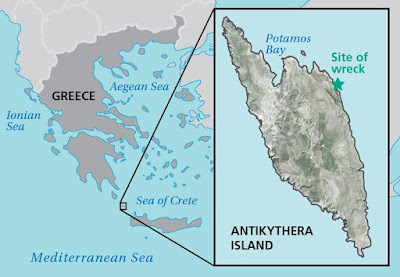 Site of the Antikythera shipwreck (2021)
Site of the Antikythera shipwreck (2021)It is not known where the device originated: certainly somewhere in the Eastern Mediterranean, possibly in Corinth. In 2008 the Antikythera Mechanism Research Project "identified the calendar on the Metonic Spiral as coming from Corinth, or one of its colonies in northwest Greece or Sicily." This led them to posit a possible connection with Syracuse, which was both "a colony of Corinth and the home of Archimedes."
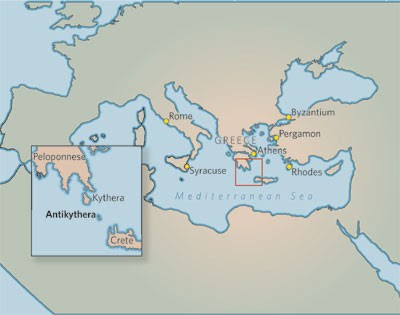 The Eastern Mediterranean at the time of the Antikythera shipwreck (2006)
The Eastern Mediterranean at the time of the Antikythera shipwreck (2006)However, more recent research has demonstrated that while this calendar is of the Corinthian type, it cannot be that of Syracuse. Other suggested points of origin for the device include Pergamon, home of the celebrated Library of Pergamum, second only in importance to the Library of Alexandria. However:
The ship carrying the device contained vases in the Rhodian style, leading to a hypothesis that it was constructed at an academy founded by Stoic philosopher Posidonius on that Greek island. Rhodes was a busy trading port and centre of astronomy and mechanical engineering, home to astronomer Hipparchus, who was active from about 140-120 BC. The mechanism uses Hipparchus' theory for the motion of the Moon, which suggests he may have designed or at least worked on it.- Wikipedia: Antikythera mechanismThe device is estimated to have been built in the late second century BCE or the early first century BCE.
•
 Computer model of the Antikythera mechanism (2021)
Computer model of the Antikythera mechanism (2021)How ought one to conclude this strange tale of scholarly rivalry and eventual, triumphant discovery? The Ancient Greeks (and, to a lesser extent, Romans) clearly deserve far more credit for their brilliance than we, their arrogant descendants, gave them credit for. Whoever the genius was who originated this particular class of devices - Archimedes or Hipparchus both seem possible suspects - they were certainly not working in a vaccuum.
Let's face it, there's a huge amount we still don't know about Greek (and Babylonian) science - not to mention the great achievements of their inheritors, the Islamic scholars of Baghdad and Córdoba, between the eighth and thirteenth centuries, before the Mongol conquest in 1258. The Renaissance inherited far more than we ever guessed from these predecessors. If we have seen further - to paraphrase Newton - it is only by standing on the shoulders of these giants.
Jo Marchant may have jumped the gun slightly in assuming that the mysteries of the Antikythera mechanism had been more or less solved by 2008, the date of her book. It's a fairly venal error, though. Her book remains a rattling good read and - until a better account comes along - well worth the trouble of hunting out.
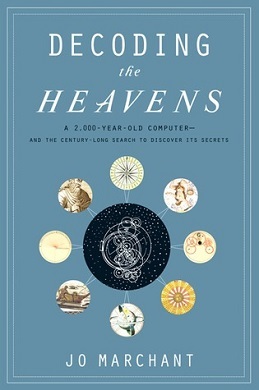 Jo Marchant: Decoding the Heavens (2008)
Jo Marchant: Decoding the Heavens (2008)•
Published on August 08, 2024 13:47
August 4, 2024
2,000,000+ Hits!
 2,000,110 Pageviews (5/8/2024)
2,000,110 Pageviews (5/8/2024)I wrote a post a little over five years ago about breaking the million hit barrier on this blog. I'm glad to see that the traffic must have more than doubled over this period, as it took me more than a dozen years to reach that original figure.

1,000,000 Pageviews (14/6/06-6/12/18)
As I said in that earlier post:
I find it rather amazing that this most self-indulgent of websites, dedicated to so many subjects which I suspect I'm quite unusual in finding fascinating - bibliography, ghosts, poetry, the 1001 Nights, poetry readings and book-launches - should have clocked up so many individual hits ...
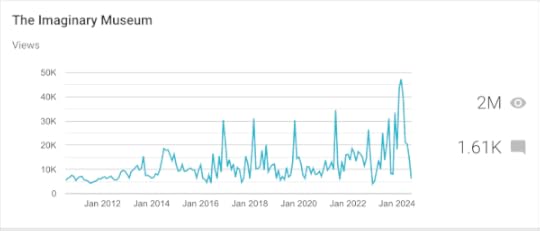 Frequency of hits
Frequency of hitsAdmittedly some of the more recent increase in traffic took place during the Covid lockdowns, when people were more prone to itinerant scrolling. However, if anything, the number of hits on my posts seems to have grown over the past few months, as you can see from the graph above.
Mind you, I do understand what a blunt instrument such counters can be. There's nothing qualitative about this data. A long read of a post will show up just the same as a momentary glance at a headline or an image.
 Location of hits
Location of hitsThey're not all from me, either. There's a little link you can click on to make sure that your own pageviews don't get counted in the total, otherwise it would all seem a bit incestuous.
 Countries of origin
Countries of originAnd as for the countries the hits are coming from, why so many from France, for instance? Why more from Russia (and Singapore) than from New Zealand? It's hard to reach clear conclusions about such matters, beyond noting the bare facts.
More to the point, though, I recently conducted a census of all the various websites I operate (you can find a complete list of them here, if you're curious). The nearest contender to this one, The Imaginary Museum , was my book collection site, A Gentle Madness , which has reached 439,131 pageviews. Most of the others were considerably less than that - though I was pleased to see that our Aotearoa New Zealand Poetry Sound Archive site has clocked up 319,446 hits.
In total, they came to approximately four and a half million pageviews, so I'd have to say that this long experiment on online writing / publishing must be seen as a success. I don't see how I could ever reached anything like that number of people by conventional means.
I know that blogs are now considered passé - but then the same fate seems to overtake each new social media platform in turn: even the giants of the internet, Instagram, X [the site formerly known as Twitter], Tik-tok et al. Enforced obsolescence pursues us all.
For my own part, though, I still like blogs. They're a great way to comment on the world around you - albeit usually to a very specialised sub-tribe of users. In my case this includes bookhounds and pop culture vultures generally.
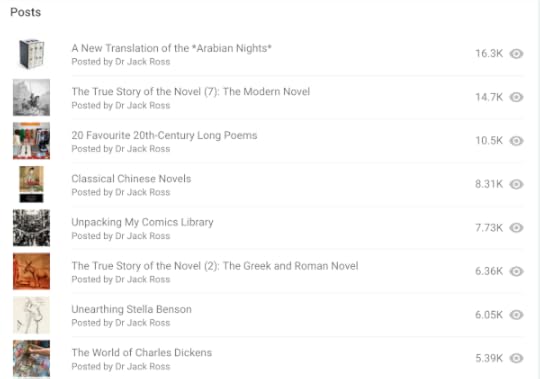 Favourite Posts (5/8/24)
Favourite Posts (5/8/24)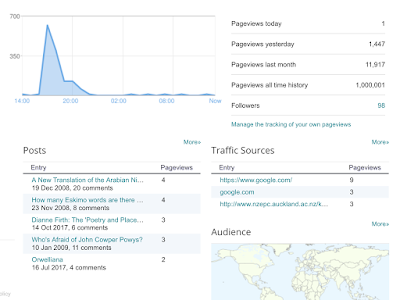
Pageviews (6/12/18)
•
Published on August 04, 2024 12:59
July 21, 2024
Operation Mincemeat
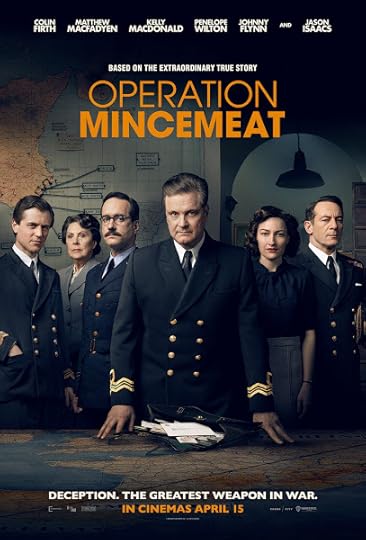 John Madden, dir. Operation Mincemeat (2021)
John Madden, dir. Operation Mincemeat (2021)How was it John Lennon put it in "A Day in the Life" (1967)?
I saw a film today, oh boyThings haven't changed all that much in the sixty-odd years since then. The English Army are still winning the war, only now they're mostly doing it by being fiendlishly clever and outfoxing the Germans at their own game ...
The English Army had just won the war
A crowd of people turned away
But I just had to look
Having read the book
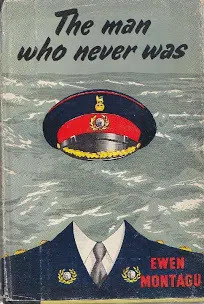 Ewen Montagu: The Man Who Never Was (1953)
Ewen Montagu: The Man Who Never Was (1953)But then, I too have read the book: in this case, Ewen Montagu's best-selling account of just how smart he and his chums at Naval intelligence had been in planting a bunch of forged letters on the body of a fake officer and floating it onto the coast of neutral Spain.
The idea was to persuade the German high command that the Allies' next objective, after their successful North African campaign, would be to invade Sardinia and Greece - not the actual (and most obvious) target, Sicily.
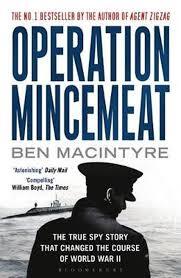 Ben Macintyre: Operation Mincemeat (2010)
Ben Macintyre: Operation Mincemeat (2010)Not everything about this operation could be revealed in 1953 - in particular, the existence of Ultra intelligence - so another book has now been written to bring the story up-to-date: Ben Macintyre's Operation Mincemeat: The True Spy Story that Changed the Course of World War II.
But did it? Change the course of World War II, that is? Opinions seem to differ on that one. "The full effect of Operation Mincemeat is not known, but Sicily was liberated more quickly than anticipated and losses were lower than predicted", is Wikipedia's verdict.
Ultra decrypts of German messages showed that the Germans fell for the ruse. German reinforcements were shifted to Greece and Sardinia before and during the invasion of Sicily; Sicily received none.On the other hand, Michael Howard, in his book Strategic Deception in the Second World War (1995):
while describing Mincemeat as "perhaps the most successful single deception operation of the entire war", considered Mincemeat and Barclay [the larger scheme of "bogus troop movements, radio traffic, recruitment of Greek interpreters, and acquisition of Greek maps"] to have less impact on the course of the Sicily campaign than Hitler's "congenital obsession with the Balkans."
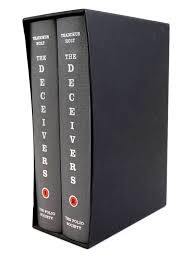 Thaddeus Holt: The Deceivers (2004)
Thaddeus Holt: The Deceivers (2004)Thaddeus Holt, in his own exhaustive history The Deceivers: Allied Military Deception in the Second World War is particularly critical of the way in which Montagu's book - possibly through no fault of his - has led many people to assume that this was the only important piece of deception going on at the time of the invasion of Sicily.
John Madden's film goes far further in this respect. There's scarcely a moment where one character or another isn't emoting away about how their work could alter the course of the war, save thousands of lives, and affect the whole history of civilisation.
Ian Fleming, who did indeed have a minor role in the real Mincemeat operation, is also given an exceptionally pompous - and rather out of character, for anyone who's ever read one of his thrill-a-minute books - John le Carré-esque monologue to intone from time to time to spike up the action.
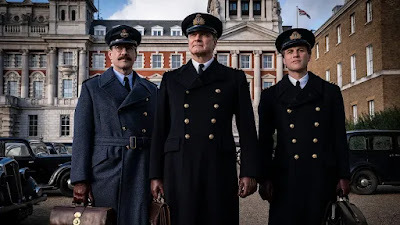 Giles Keyte: Operation Mincemeat (2021)
Giles Keyte: Operation Mincemeat (2021)l-to-r: Colin Firth, Matthew Macfadyen & Johnny Flynn
All in all, it certainly seems to have the makings of a rattling good yarn. The story is a fascinating one - true, too (for the most part) - and all the usual suspects from the pantheon of British acting are there in strength.
Ian Fleming: [narrating while typing] In any story, if it's a good story, there is that which is seen, and that which is hidden. This is especially true in stories of war.
... There is the war we see, a contest of bombs and bullets, courage, sacrifice, and brute force, as we count the winners, the losers, and the dead.
... But alongside that war, another war is waged. A battleground in shades of gray, played out in deception, seduction, and bad faith. The participants are strange. They are seldom what they seem, and fiction and reality blur. This war is a wilderness of mirrors in which the truth is protected by a bodyguard of lies. This is our war.
That it doesn't quite succeed in this endeavour is mainly down to Michelle Ashford's rather mawkish screenplay. For a start, did we really need the (completely fictional) love triangle between Colin Firth, Matthew Macfadyen and Kelly MacDonald?
A rather portly Colin Firth, who plays former-King's-Counsel-turned-spy Ewen Montagu, looks far more interested in glugging down another glass of whisky than having a quick snog with his nattily turned out junior Kelly MacDonald (Jean Leslie).
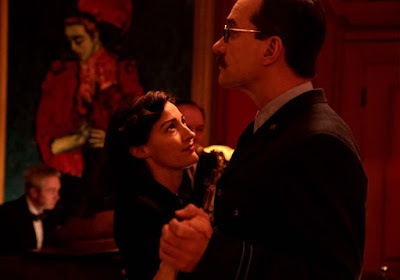 Matthew Macfadyen & Kelly MacDonald (2021)
Matthew Macfadyen & Kelly MacDonald (2021)Exactly what part the moustachioed Matthew Macfadyen - impersonating the actual brains behind the operation, Charles Cholmondeley - imagines himself to be playing is unclear to me. Certainly he does the worst job of trying to pick up a girl in a cinema, and subsequently in a nightclub, and finally in the office, that I've ever seen.
And yet Macfadyen succeeded completely in reinventing himself as a wolfish corporate predator in the Succession (2018-23) TV series. Why didn't they give him some of that material to work with here?
The point of this post, however, is not so much to slag off the film, which I did still enjoy - though it seemed to me that it could have been considerably better with a little judicious pruning of its longer, more weepy scenes - than to talk about its larger implications as a guide to prevailing British attitudes towards the Second World War.
•
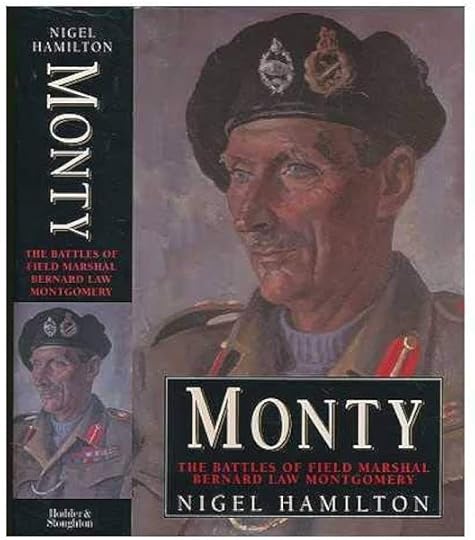 Nigel Hamilton: Monty: The Battles of Field Marshal Bernard Law Montgomery (1994)
Nigel Hamilton: Monty: The Battles of Field Marshal Bernard Law Montgomery (1994)The book above, which I picked up recently in a second-hand shop, is a condensation of Nigel Hamilton's exhaustive three-volume, authorised biography of Field Marshall Montgomery (1981-86), possibly the most controversial figure in Second World War historiography.
Monty's version of the war in Europe - expressed in his numerous volumes of memoirs, and repeated more or less verbatim by Hamilton's official biography - was that it could easily have been won by the end of 1944 if only the Americans had left him in overall command of all Allied ground forces after the breakout from Normandy.
Failing that, if they (meaning Eisenhower and his bosses in Washington) had just listened to Monty's suggestion that most of the available resources and manpower should be allocated to him in order to conduct his single-thrust attack into Northern German - rather than frittering it away on side-shows such as General Patton's advance in the South, and the subsidiary landings in the South of France - then he would have mopped up the Nazis easily.
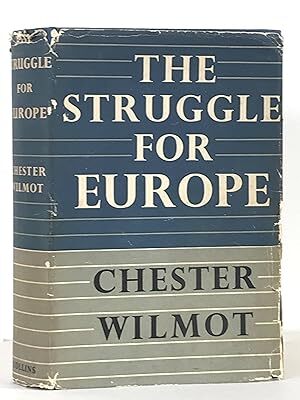 Chester Wilmot: The Struggle for Europe (1952)
Chester Wilmot: The Struggle for Europe (1952)This is certainly the view accepted immediately after the war by such influential witnesses as Australian war correspondent Chester Wilmot. It also ties in nicely with the English view of the Americans - both troops and generals - as inexperienced and over-confident. Not to mention the "over-paid, over-sexed, and over here" mythology of discord between the two nationalities, as expressed with supreme wit and pin-point accuracy in the classic British sit-com Dad's Army (1968-1977):
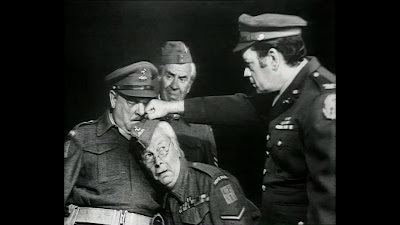 Dad's Army: My British Buddy (1973)
Dad's Army: My British Buddy (1973)The question remains, though, was Monty the supreme strategist he claimed to be? Were all of his reverses - Caen, Arnhem - other people's fault? Was it feasible to have so notoriously touchy and undiplomatic a general in charge of an army consisting predominantly of American rather than British troops?
Anxious as they are to promote Montgomery's virtues, the Brits suffer from the supreme disadvantage of not controlling Hollywood. Their occasional successes there come as flashes in the pan in a more uniform tale of American exceptionalism.
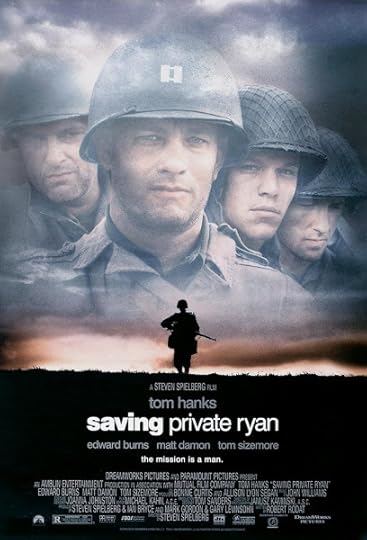 Steven Spielberg, dir. Saving Private Ryan (1998)
Steven Spielberg, dir. Saving Private Ryan (1998)Take that propaganda masterpiece Saving Private Ryan, for instance. There's a scene early on where Ted Danson, playing a hardbitten combat officer, has a brief dialogue with Tom Hanks (Captain Miller):
That line about Monty being "overrated" has led to apoplectic exchanges up and down the internet. This, for example, from the History forum Historum (4/2/2014):
Captain Hamill: What have you heard? How's it all falling together?
Captain Miller: Well, we got the beachhead secure. Problem is Monty's taking his time moving on Caen. We can't pull out till he's ready, so...
Captain Hamill: That guy's overrated.
Captain Miller: No argument here.
this comment about Monty being ''overrated'' was factually wrong, even if some US troops said it at the time.Which was answered, later that day, as follows:
The pre-D-Day plan was for Monty and the Canadians to take on the bulk of the SS and German armour (which were behind Caen), whilst the less-challenged US troops (in the western flank) in Brittany, under the dashing Patton, would break out (as they did) and deal a mighty blow in the enemy flank. Which they did.
I'm one of Montgomery's detractors. He is overrated, in my view. He had a chronic case of the slows that, while might have resulted in less initial casualties, may well have caused more casualties in the long run. As for Montgomery at Normandy, I might buy the argument that Monty was supposed to take the brunt of Rommel's reserve allowing the Americans under Bradley (Patton was still commanding a fictitious army in England) to break out IF the historical record supported that. It does not. Carlo d'Este has proven convincingly that that thesis was an invention by Monty after the fact."Endless are the arguments of mages," as Ursula K. Le Guin once put it - or, as in this case, of historians and history buffs.
... I might also buy that my view of Monty was a product of my American viewpoint IF I viewed all British generals as incompetent (I don't - Alexander and Slim were both exceptional, in my view) and all American generals as able to move mountains (I'm not a huge fan of Mark Clark, George Patton, and mostly Dugout Douglas MacArthur). Why is it that criticism of Monty must be based on national agenda?
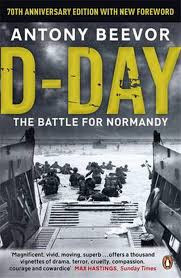 Antony Beevor: D-Day: The Battle for Normandy (2009)
Antony Beevor: D-Day: The Battle for Normandy (2009)If there is a concensus, though, I'd say that my own reading of some of the more recent accounts of D-Day by a range of historians, American and British - in particular, Stephen E. Ambrose and Antony Beevor - has led me to the conclusion that few of them now accept that Monty's failure to capture Caen on the day of the invasion was somehow "intentional."
Nor do many writers now repeat that idea of a "pre-D-Day plan" which involved little or not movement on the part of British and Commonwealth troops in order to "set up" a breakthrough by the Americans. That is indeed (more or less) what happened, but whether it was planned that way, as Monty's advocates continue to insist, seems increasingly doubtful. The facts appear to be otherwise.
The supreme argument for American bluster and incompetence against British calmness and professionalism is, of course, Hitler's Ardennes Offensive, the so-called "Battle of the Bulge." This was certainly an avoidable disaster, and Eisenhower apologists (such as the late Stephen Ambrose) have a difficult job arguing otherwise.
Whether Monty made a decisive contribution to the containment of the German forces on that occasion is debatable - his fans say yes, his detractors no - but one thing is for certain, the crowing press conference he gave on the subject destroyed once and for all any chance he had of being given command over any more American troops.
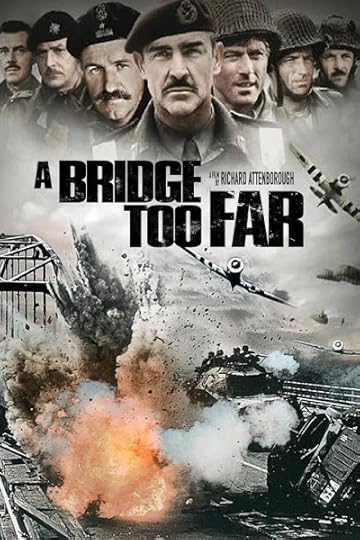 Richard Attenborough, dir. A Bridge Too Far (1977)
Richard Attenborough, dir. A Bridge Too Far (1977)What's more, the complete - and equally avoidable - débâcle which was Operation Market Garden, the airborne assault on Arnhem and the single road leading to it, was presided over and largely designed by Montgomery. Though he attempted later to shuffle off the blame, this should have put paid to his reputation as a master strategist or tactician on the level of Marlborough or Wellington.
Hollywood has had a good deal to say on that subject also - not only in the classic war movie A Bridge Too Far, scripted by William Goldman from Cornelius Ryan's book (albeit with an English director and a largely British cast), but also in the supreme act of American triumphalism that is the TV mini-series Band of Brothers, created by Tom Hanks and Steven Spielberg in tandem:
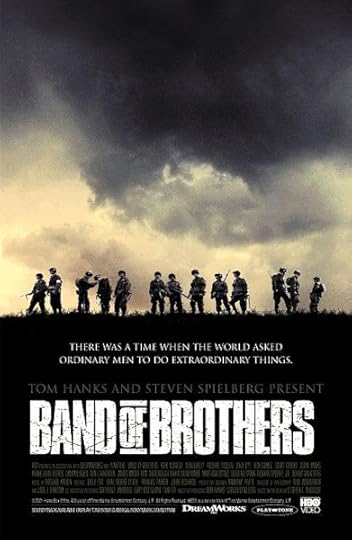 Richard Attenborough, dir. Band of Brothers (2001)
Richard Attenborough, dir. Band of Brothers (2001)•
 Morten Tyldum, dir. The Imitation Game (2014)
Morten Tyldum, dir. The Imitation Game (2014)"Strange all this difference should be / 'Twixt Tweedledum and Tweedledee" ... Who did actually win the war on the Western Front? Well, if it hadn't been for British intransigence and stubborn refusal to admit that they were defeated in 1940, there wouldn't have been a war to win - there or anywhere else.
Without the resources (both in troops and matériel) provided by the Americans, there couldn't have been a successful invasion of Europe in 1944 or at any other time.
But then, for that matter, without the titanic victories of the Red Army at Stalingrad and Kirsk, the Germans would probably have been able to marshall the resources to overwhelm the fragile Allied bridgehead in Normandy.
All these great nations made immense sacrifices for their common cause - the Russian people far beyond any others. Maybe it's time to suspend these nationalistic squabbles, then, and admit the virtues as well as the vices of the squabbling British and American generals in Italy and Western Europe?
They do, admittedly, read like a pack of prima donnas at times - more concerned with their own press coverage and the number of stars on their shoulders than with winning the war. But, after all, they were victorious. And the Germans were far from being negligible adversaries at any stage.
The Imitation Game is another interesting test case in this discussion. It's far more fictionalised even than Operation Mincemeat, though one can see the dramatic reasons for that. It's also a far better film, mainly due to a taut script and excellent performances from its stellar cast.
 Alan Turing (1912-1954)
Alan Turing (1912-1954)But, once again, while no praise is sufficient for the genius of Alan Turing, it's a shame that the immensely important part paid by the Poles in the long saga of breaking the Enigma cipher had to be left out entirely from the cinematic record:
The German plugboard-equipped Enigma became the principal crypto-system of the German Reich and later of other Axis powers. In December 1932 it was "broken" by mathematician Marian Rejewski at the Polish General Staff's Cipher Bureau, using mathematical permutation group theory combined with French-supplied intelligence material obtained from a German spy. By 1938 Rejewski had invented a device, the cryptologic bomb, and Henryk Zygalski had devised his sheets, to make the cipher-breaking more efficient. Five weeks before the outbreak of World War II, in late July 1939 at a conference just south of Warsaw, the Polish Cipher Bureau shared its Enigma-breaking techniques and technology with the French and British.-Wikipedia: Cryptanalysis of the EnigmaThe Imitation Game ends with the statement that the deciphering of the German codes may have shortened the war by two years, and thus saved vast numbers of lives. However, "according to the best qualified judges", these Polish contributions "accelerated the breaking of Enigma by perhaps a year."
Once again, the plucky little Britain narrative has to be pushed at the expense of historical truth. Those of us who "read the book" may know of the superhuman efforts already made to crack Enigma long before Bletchley Park was even born or thought of, but filmgoers are encouraged to see it as yet another example of inspired English amateurism winning the day over stultifying professional inertia.
Perhaps we need to go back as far as the 1962 wide-screen epic The Longest Day, based on the bestseller by Irish-journalist-turned-US-citizen Cornelius Ryan, to see anything resembling even-handed treatment of the respective contributions made by these warring nationalities to their eventual, hard-won success. Would it hurt us so much to try to emulate that attitude today?
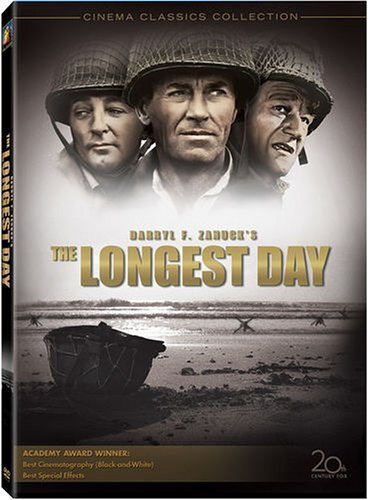 Darryl F. Zanuck, prod.: The Longest Day (1962)
Darryl F. Zanuck, prod.: The Longest Day (1962)•
Published on July 21, 2024 16:03
July 14, 2024
Must We Burn Alice Munro?
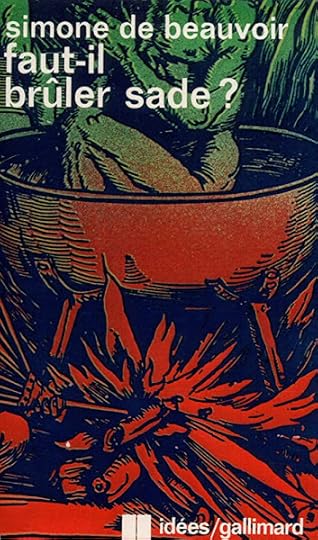 Simone de Beauvoir: Faut-il brûler Sade ? (1951)
Simone de Beauvoir: Faut-il brûler Sade ? (1951)I wrote a post about the Chinoiserie-inflected "Kai Lung" stories of English writer Ernest Bramah a year or so ago. In it, I mentioned Simone de Beauvoir's classic essay Must We Burn de Sade?, first published in the early 1950s. Certainly the ethnic stereotyping and yellow-face clichés with which Bramah's work is saturated are extremely reprehensible by modern standards.
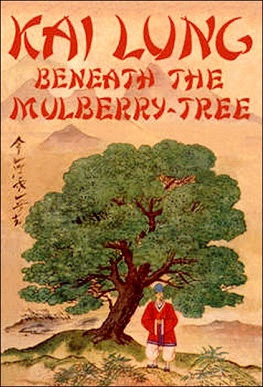 Ernest Bramah: Kai Lung Beneath the Mulberry Tree (1940)
Ernest Bramah: Kai Lung Beneath the Mulberry Tree (1940)And yet ... given that it's the very absurdity and exaggeration of such traits which constitutes the point of these hundred-year-old stories - as well as any humorous content they may contain - it does seem a little like breaking a butterfly on a wheel to insist on explicit public condemnation of his work.
After all, in a world where Robert van Gulik's not dissimilarly flavoured "Judge Dee" detective stories can be filmed by a Chinese production company, for mainland Chinese audiences, conventional ideas of cultural appropriation don't appear to apply so straightforwardly anymore.
 Alice Munro: Carried Away: A Selection of Stories (2006)
Alice Munro: Carried Away: A Selection of Stories (2006)But now a far more serious test-case has arisen. Hot on the heels of the accusations of sexual assault against Sandman -creator Neil Gaiman, some truly awful revelations about Nobel-prize-winning Canadian writer Alice Munro have come out in an op-ed article written by her estranged daughter, Andrea Skinner.
Nor is this one of those "he said / she said", Mommy Dearest scandals where true believers can continue to insist on the innocence of their hero. Alice Munro's second husband, Gerald Fremlin, sexually assaulted his stepdaughter Andrea in 1976, when she was nine years old. He was convicted of this offence - for which he received a suspended sentence and two years probation - in 2005.
In 1992, at the age of 25, Andrea Skinner
wrote a letter to Munro, finally coming forward about the abuse.What a prince! It was on the evidence of these letters that he was convicted, however, so he may have overreached a bit there.
Munro told her she felt betrayed and likened the abuse to an affair, a response that devastated Skinner, she wrote.
In response, Fremlin wrote letters to Munro and the family, threatening to kill Skinner if she ever went to the police. He blamed Skinner for the abuse and described her as a child as a "home wrecker." He also threatened to expose photos he took of Skinner when she was a girl.
Munro went back to Fremlin and stayed with him until he died in 2013 ... Munro allegedly said “that she had been ‘told too late,’ she loved him too much, and that our misogynistic culture was to blame if I expected her to deny her own needs, sacrifice for her children, and make up for the failings of men. She was adamant that whatever had happened was between me and my stepfather. It had nothing to do with her," Skinner wrote in her essay.
 Alice Munro (1931-2024)
Alice Munro (1931-2024)In any way you've got to hand it to Munro. She certainly came out swinging! And yet the courage and restraint that Andrea Skinner has shown in not airing her own story till her mother was dead seems to me far more admirable.
Nor can I quite follow the reasoning which equates any critique of Tammy Wynette-style standing by your man with "misogyny", but clearly Munro thought it was unreasonable for anyone to expect her to leave her husband for good just because he was a murderous paedophile. Perhaps it is. I can't help feeling that it might slightly inhibit the banter over the conrnflakes each morning, but that's just me.
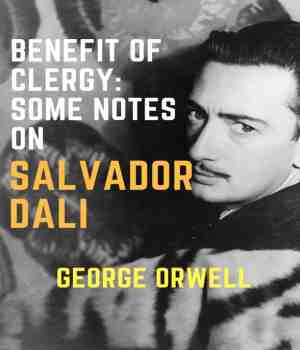 George Orwell: (1953)
George Orwell: (1953)In his 1944 essay "Benefit of Clergy: Some Notes on Salvador Dali", Orwell grapples with the question of whether or not one can admire the work of someone who is undoubtedly a reprehensible human being. He says of the then recently published Secret Life of Salvador Dali:
If it were possible for a book to give a physical stink off its pages, this one would — a thought that might please Dali, who before wooing his future wife for the first time rubbed himself all over with an ointment made of goat's dung boiled up in fish glue. But against this has to be set the fact that Dali is a draughtsman of very exceptional gifts. He is also, to judge by the minuteness and the sureness of his drawings, a very hard worker. He is an exhibitionist and a careerist, but he is not a fraud. He has fifty times more talent than most of the people who would denounce his morals and jeer at his paintings. And these two sets of facts, taken together, raise a question which for lack of any basis of agreement seldom gets a real discussion.
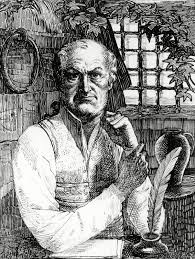 Donatien-Alphonse-François, Comte de Sade (1740-1814)
Donatien-Alphonse-François, Comte de Sade (1740-1814)That question is, I presume, whether or not art can co-exist with depravity. Coming back to Simone de Beauvoir's essay, mentioned above, should the Marquis de Sade be seen as an important writer and thinker, or simply as a revolting cockroach who ought to have been crushed on sight? Orwell continues:
The point is that you have here a direct, unmistakable assault on sanity and decency; and even — since some of Dali's pictures would tend to poison the imagination like a pornographic postcard — on life itself. What Dali has done and what he has imagined is debatable, but in his outlook, his character, the bedrock decency of a human being does not exist. He is as anti-social as a flea. Clearly, such people are undesirable, and a society in which they can flourish has something wrong with it.The people who simply see him as an undesirable, and refuse even to acknowledge the possibility of any talent in such a deviant, he continues, at any rate have the virtue of consistency:
But if you talk to the kind of person who can see Dali's merits, the response that you get is not as a rule very much better. If you say that Dali, though a brilliant draughtsman, is a dirty little scoundrel, you are looked upon as a savage. If you say that you don't like rotting corpses, and that people who do like rotting corpses are mentally diseased, it is assumed that you lack the aesthetic sense ... On the one side Kulturbolschevismus: on the other (though the phrase itself is out of fashion) ‘Art for Art's sake.’ Obscenity is a very difficult question to discuss honestly. People are too frightened either of seeming to be shocked or of seeming not to be shocked, to be able to define the relationship between art and morals.
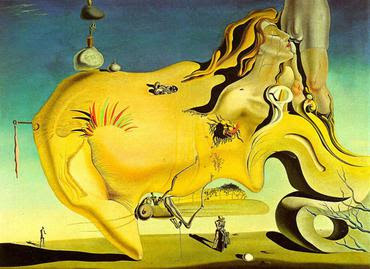 Salvador Dalí: The Great Masturbator (1929)
Salvador Dalí: The Great Masturbator (1929)In the age of "cancel culture" (so-called), these questions have become even harder to debate. However, as Beauvoir reminds us, burning Sade - or banning his works and pillorying anyone who dares to read them - is unlikely to advance us in our attempts to understand the stranger recesses of human psychology.
In my younger days, I felt very strongly that (in Thomas Hardy's words):
if way to the Better there be, it exacts a full look at the Worst.- "In Tenebris II"In fact I wrote a whole novel in this spirit, Nights with Giordano Bruno (2000). It was characterised as follows by a local reviewer:
The untitled cover of this book opens to horrors akin to those of Pandora. Not all the contents are evil but the spirit of darkness certainly prevails.
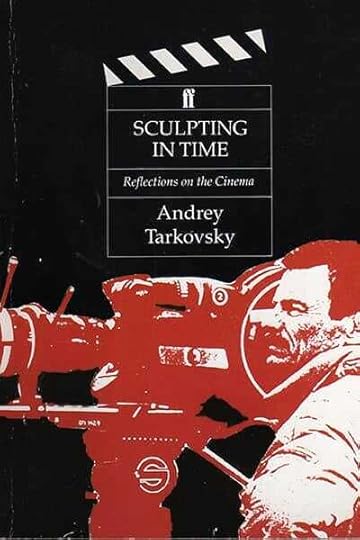 Andrei Tarkovsky: Sculpting in Time (1986)
Andrei Tarkovsky: Sculpting in Time (1986)"Not all the contents are evil." Fortunately this was not the view which prevailed among other reviewers and readers, most of whom seemed to have a pretty good idea what I was driving at.
Perhaps the best way to sum it up is in the words of the Russian film director Andrei Tarkovsky, who said in his book of essays on cinema, Sculpting in Time:
To tell of what is living, the artist uses something dead; to speak of the infinite, he describes the finite.Unable to speak of heaven without descending into banality, instead you might choose to describe one of the many hells - a much easier assignment! By portraying that one thing, however, the lines of its antithesis are also being made out at the same time, by implication.
It sounds paradoxical, but it's really not. It's much harder to draw a saint than a villain, but to make your saint believable is virtually impossible. That's not to say that saintliness is an undesirable attribute, however. We could do with far, far more of them. And I'm convinced that they do exist. I'm just not one of them.
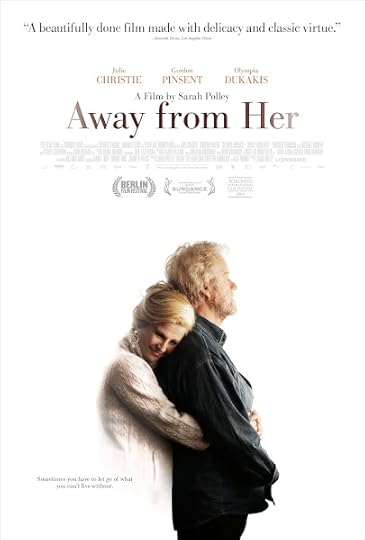 Sarah Polley, dir.: Away from Her (2006)
Sarah Polley, dir.: Away from Her (2006)Nor, it appears, was Alice Munro. Before all this erupted, I had two main associations with her work.
The first was the Sarah Polley film above, based on Munro's 1999 story "The Bear Came Over the Mountain". The grim paradox in the plot is that a man who is forced to institutionalise his wife, who is suffering from Alzheimer's disease, then has to watch her shift her affections to another man, Aubrey, a wheelchair-bound mute at the same nursing home. She becomes convinced that it is Aubrey with whom she has had a long-term relationship, whereas her actual husband is now a stranger to her.
The film (and the story) are poignant and powerful, but there's a certain coldness and cruelty behind the idea which explains at least part of its success, it seems to me.
The second thing was a short story conference in Shanghai which Bronwyn and I attended in 2016. After a while it became apparent that virtually all of the earnest young graduate students there were working on Alice Munro, and (accordingly) giving papers on her stories. She was definitely the author du jour for them.
This came as a bit of a surprise to those of us still enmeshed in the web of Raymond Carver and the dirty realists. Alice Munro? Who she? We determined to find out, so one of the first things we did when we got home was to buy a copy of the Everyman edition of her selected stories, pictured near the top of this post.
I can't say I was particularly turned on by her work. I could see how it accomplished it was, but it didn't seem quite my sort of thing.
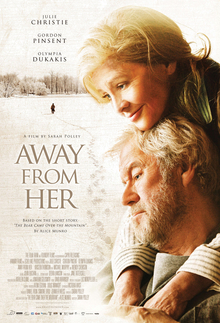 Julie Christie and Gordon Pinsent in Away from Her
Julie Christie and Gordon Pinsent in Away from HerNow, in retrospect, the plot of Away from Her seems more meaningful than ever. For a start, Munro herself suffered from dementia "for at least 12 years". The idea that the wife needs her new relationship, with the wheelchair-bound mute Aubrey, more than the former one with her actual husband is also a suggestive one. It may seem illogical to outsiders, but it's truer to her own emotional temperature.
The horrible, almost unpalatable truth about this scandal based on a mother's failure to support or even empathise with her own daughter, is that it's likely to do nothing but good to Munro's career. There may be a few temporary blips in sales, but more readers are drawn to turbulent, demon-ridden souls such as Dostoyevsky and Dickens than they are to the sanity and order of better-balanced authors.
Did Dickens lose any readers over the late revelation of his cruel rejection of his wife in order to pursue an affair with the young actress Nelly Ternan? Nelly, it seems, had little choice in the matter - neither did Mrs. Dickens. His saccharine morality showed its pinchbeck quality once and for all in his later life. And yet we continue to pore over the complexities of his last fictions, full of young heroines sacrificing themselves for self-pitying older men.
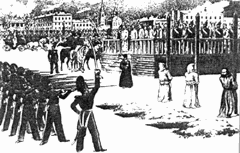 Mikhail Petrashevsky: Dostoyevsky's mock execution (1849)
Mikhail Petrashevsky: Dostoyevsky's mock execution (1849)Fyodor Dostoyevsky was a gambler, a drunkard, a rabid anti-semite. He appears to have suffered from lifelong PTSD after experiencing a mock execution in front of one of the Tsar's firing squads, followed by exile to Siberia. As a result, it's not hard for us to believe in the appallingly damaged characters who inhabit such novels as Crime and Punishment or The Devils.
I must confess to having yawned once or twice when I first started reading Munro's stories. They didn't engage me as much as the works of (say) her near contemporaries Margaret Atwood or Ursula Le Guin. Now, however, there's more of a demonic edge to them. It's perfectly possible - even likely - that she could feel her own mind going as she watched the horrid ironies of her own short story reenacted by the actors in Close to Her.
Nor can she have been blind to the fact that her dirty little secret was bound to come out in the end. Just as the illegitimate daughter whose very existence Wordsworth hid from the world was eventually discovered, giving the lie to so many of his more pompous moral pronouncements - but also explaining so much about him and his transformation from youthful rebel to faithful servant of the establishment - so Munro's hateful attitude towards her own daughter must have continued to nag at her as she conducted her minute analyses of the mindsets and actions of provincial Canadians.
We haven't stopped reading him yet, and no doubt the same will apply to Alice Munro. However much we might deplore their actions, this tends to have the paradoxical effect of deepening our interest in their writings, rather than erasing it.
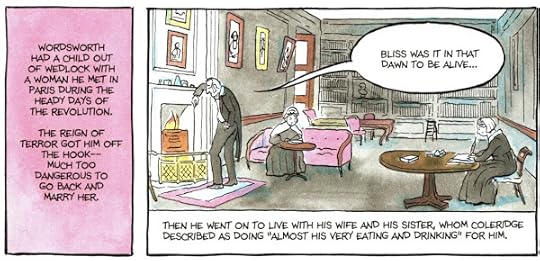 Alison Bechdel: The Secret To Superhuman Strength (2021)
Alison Bechdel: The Secret To Superhuman Strength (2021)•
 Alice Munro (2006)
Alice Munro (2006)Alice Ann Munro (née Laidlaw)
(1931–2024)
Books I own are marked in bold:Collections:
Dance of the Happy Shades (1968)Lives of Girls and Women (1971)Something I've Been Meaning to Tell You (1974)Who Do You Think You Are? [aka "The Beggar Maid: Stories of Flo and Rose"] (1978)The Moons of Jupiter (1982)The Progress of Love (1986)Friend of My Youth (1990)Open Secrets (1994)The Love of a Good Woman (1998)Hateship, Friendship, Courtship, Loveship, Marriage [aka "Away from Her"] (2001)Hateship, Friendship, Courtship, Loveship, Marriage: Stories. London: Chatto & Windus, 2001. Runaway (2004)Runaway: Stories. Introduction by Jonathan Franzen. 2004. Vintage Books. London: Random House, 2005. The View from Castle Rock (2006)Too Much Happiness (2009)Dear Life (2012)
Compilations:
Selected Stories 1968-1994 [aka "A Wilderness Station: Selected Stories, 1968–1994"] (1996)No Love Lost (2003)Vintage Munro (2004)Carried Away: A Selection of Stories [aka "Alice Munro's Best: A Selection of Stories"]. Introduction by Margaret Atwood (2006)Carried Away: A Selection of Stories. Introduction by Margaret Atwood. 2006. Everyman’s Library, 302. New York: Alfred A. Knopf, 2008. My Best Stories (2009)New Selected Stories (2011)Lying Under the Apple Tree. New Selected Stories (2014)Family Furnishings: Selected Stories 1995–2014 (2014)
•
 Alice Munro & her family:
Alice Munro & her family:l-to-r: Jenny, Sheila, Alice & Andrea
Published on July 14, 2024 17:15
June 30, 2024
My new book Haunts is available today!
 Unpacking Copies of Haunts (27/6/24)
Unpacking Copies of Haunts (27/6/24)[photograph: Bronwyn Lloyd
The official publication date for my new collection of short stories, Haunts , is today, Monday 1st July, 2024.
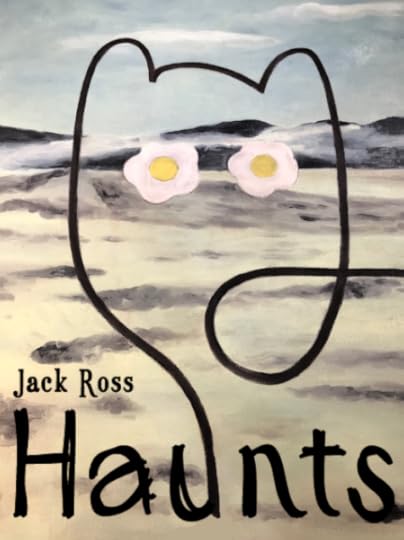 Cover image: Graham Fletcher (by courtesy of the artist) /
Cover image: Graham Fletcher (by courtesy of the artist) /Cover design: Daniela Gast (2024)
As you can see, it does bear a certain resemblance to my previous collection, Ghost Stories, also published by Lasavia Publishing five years ago.
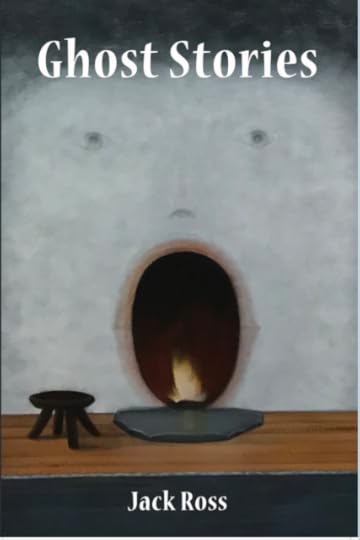
Cover image: Graham Fletcher (by courtesy of the artist) /
Cover design: Daniela Gast (2019)
Once again, it's been a great pleasure to work on the book with the Lasavia team: editor Mike Johnson, and designers Daniela Gast & Rowan Johnson. Again, just like last time, I owe a big thank you to Graham Fletcher for the use of his cover image, and (as ever) to my brilliant wife Bronwyn Lloyd for invaluable advice at every stage. Thanks, too, to Tracey Slaughter for her comments on the typescript at a crucial point of the process.
•
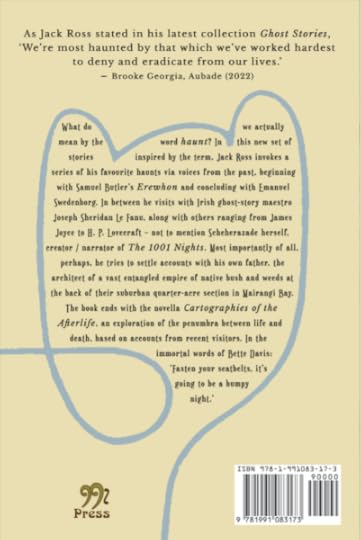
So what is the book about? The easiest thing might just be to quote from the blurb:
What do we actually mean by the word haunt? In this new set of stories inspired by the term, Jack Ross invokes a series of his favourite haunts via voices from the past, beginning with Samuel Butler’s Erewhon and concluding with Emanuel Swedenborg.
'As Jack Ross stated in his latest collection Ghost Stories, ‘We’re most haunted by that which we’ve worked hardest to deny and eradicate from our lives.'
- Brooke Georgia, Aubade (2022)
In between he visits with Irish ghost-story maestro Joseph Sheridan Le Fanu, along with others ranging from James Joyce to H. P. Lovecraft – not to mention Scheherazade herself, creator / narrator of The 1001 Nights.
Most importantly of all, perhaps, he tries to settle accounts with his own father, the architect of a vast entangled empire of native bush and weeds at the back of their suburban quarter-acre section in Mairangi Bay.
The book ends with the novella Cartographies of the Afterlife, an exploration of the penumbra between life and death, based on accounts from recent visitors.
In the immortal words of Bette Davis: ‘Fasten your seatbelts, it's going to be a bumpy night.’
Jack Ross is the author of six poetry collections, four novels, and four books of short fiction. His previous collection, Ghost Stories (Lasavia, 2019), has been prescribed for writing courses at three local universities. He’s also edited numerous books, anthologies, and literary journals, including (most recently) Mike Johnson’s Selected Poems (2023).
He blogs at http://mairangibay.blogspot.com/.
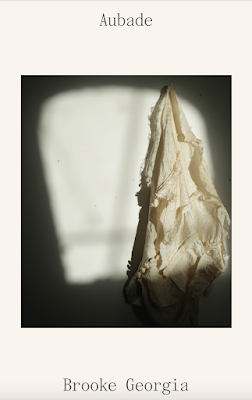 Brooke Georgia: Aubade (26/3-17/4/2022)
Brooke Georgia: Aubade (26/3-17/4/2022)The quote featured above comes from the catalogue for Brooke Georgia's solo exhibition Aubade , at Public Record in Ponsonby.
•
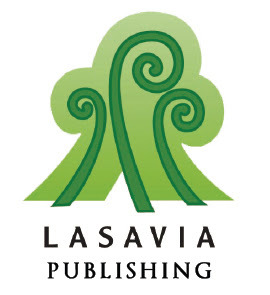
Lasavia Publishing
Another vital question is how you can obtain a copy of the book? We're planning a booklaunch a bit later in the year, but in the meantime, if you'd like to order one online, it's available from the following websites:
Google BooksAmazon.comAmazon.com.auDussmann das KulturKaufhausFishpondFoylesHatchardsMighty ApeThe NileThrift BooksWheelers
Lasavia Publishing37 Crescent Rd West
Ostend
Waiheke Island
Auckland 1081
https://www.lasaviapublishing.com/
RRP: $NZ 30.00 (+ postage)
Should you buy a copy? Well, obviously, that's between you and your conscience, but I'll conclude by quoting a few extracts from the Lasavia manifesto, written by Waiheke poet and novelist Mike Johnson:
‘When Leila Lees and I first considered establishing Lasavia Publishing, less than one in a hundred manuscripts submitted to publishers reached publication. ... Manuscripts submitted to publishers were, and still are, routinely returned unopened. ‘Mechanisms of exclusion’ as Foucault called them, are rife in the present publishing climate, particularly in New Zealand.Recent books issued by Lasavia include Max Gunn's Paybook , a novel by Graham Lindsay; Aucklanders , a collection of stories by Murray Edmond; and Mike Johnson's own Selected Poems , fruit of five decades' work in the medium.
... Publishers distrust the wild card, that which might put readers too far out of their comfort zones, as if comfort was somehow the purpose of literature. Both writers and readers lose out. Real grass roots work is lost or supplanted by celebrity culture. Only indy publishers, who don’t have to carry the overheads of big publishers, will be light enough on their feet to thrive in the new publishing environment."
•
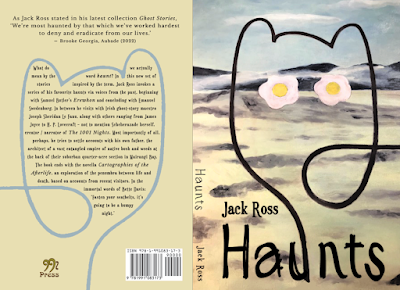
Published on June 30, 2024 13:07



